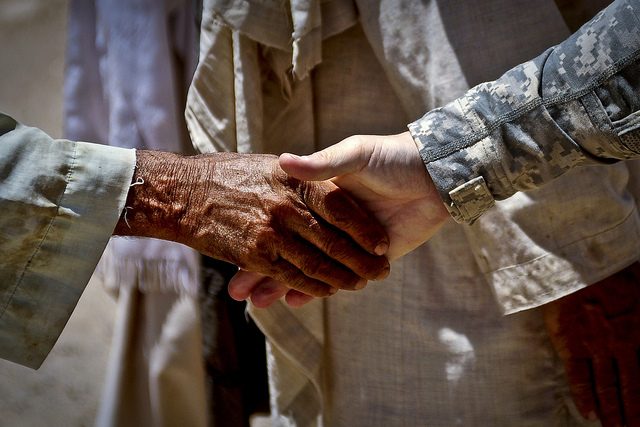

To find out more about E-IR essay awards, click here.
—
I. INTRODUCTION
According to the Uppsala Conflict Data Programme (UCDP), an internationalised internal armed conflict occurs between the government of a state and internal opposition groups with intervention from other states in the form of troops (Petterson & Wallensteen 2015: 549). This definition is problematic because it ignores a multitude of other ways in which external states intervene in civil wars. The most common form of intervention is through the sponsorship of non-state armed groups (NAGs), groups that resort to violent means in order to achieve political objectives over a period of time and do not fall under the command of a sovereign state’s armed forces (San Akca 2009: 590). During the bipolar international system of the Cold War, state support to rebels and governments was driven by a global ideological competition between the United States and the Soviet Union which saw both sides striving to proliferate opposing political systems. There was rarely a conflict in Africa, South America, Asia or Europe which did not involve these super powers and their pawns to some degree. Since the end of the Cold War, the involvement and motivations of external actors in civil wars has become less clear cut, and regional powers are increasingly partaking in this foreign policy strategy (Economist 2015).
The much mediatised conflicts in Libya, Syria, Iraq, Yemen and Ukraine, although fought by different groups for diverse reasons, all share a common characteristic: the intense involvement of regional and global powers. They are increasingly seen as theatres hosting indirect conflict between greater powers, giving a breath of new life to terms such as ‘state sponsorship’ and ‘proxy wars’ that for many had become anachronistic. In 2011, NATO provided military support to rebels fighting the Libyan dictator Muammar Gaddafi in a conflict which, although relatively short, matured into a complex and tenacious civil war. Iran, Russia, France, the UK, Saudi Arabia, Turkey and the US, amongst others, are supporting opposing sides in a highly fragmented conflict that has marred Syria for over four years, resulting in the deaths of an estimated 200,000 people and the displacement of more than 11 million people both within and beyond the Syrian borders (BBC News 2015). This conflict saw the rise of the Islamic State (ISIS), which quickly took hold in Syria, rolled into Iraq, emerged in Libya and attracted the allegiance of Islamic groups from across the world, most notably from Boko Haram in Nigeria (Celso 2015). In 2014 the United States and its allies launched a campaign of airstrikes in Iraq and Syria to help the Iraqi government, Kurdish fighters and Shiite militia groups push back ISIS. Recently, Turkey joined the campaign against ISIS but has also targeted long-time Kurdish rivals. Over the same period, Russia’s intense involvement in Eastern Ukraine led to EU and US sanctions against Russian state banks, businesses and prominent officials. There is little doubt that Vladimir Putin’s military support to pro-Russian separatists in Donetsk and Luhansk, as well as the annexation of Crimea in 2014, is part of a long struggle for geopolitical and economic dominance in former Soviet states (New York Times 2015). Less explicitly, Iran’s military and financial support to the Houthi rebels in Yemen enabled their march onto the capital Sana’a, which forced President Hadi to flee to the southern port of Aden and resulted in a Saudi-backed coalition against the rebels (Reuters 2014). Iran’s support of Shiite militia groups in Iraq, the Houthis in Yemen, long-term sponsorship of Hezbollah in Lebanon and Syria, and other groups across the Middle-East is expected to increase after a contentious nuclear deal removed longstanding economic sanctions (Foreign Policy 2015a). Alarmingly, it is within this context that wars today kill or displace more people and are proving harder to end than in past years (Foreign Policy 2015b).
This impressive list of conflicts is not exhaustive, but serves to draw attention to the prevalence of external state involvement in recent conflicts, particularly by providing support to NAGs. Although these conflicts involve external states to differing degrees, external support to NAGs appears to have diverging effects on conflict characteristics. This dissertation will investigate how it shapes relations between NAGs in multi-actor conflicts – more specifically, by determining how different forms of support affect the probability that a NAG will be in a rebel alliance or experience interrebel fighting in a given year.
The following section presents a review of relevant research on external intervention, rebel alliances and interrebel fighting in civil wars. The third section outlines the theoretical framework for how various forms of external support shape interrebel dynamics. This is done in two parts – from the perspective of the sponsor and the NAG. The key argument is that the fungibility of support reflects the resolve and engagement of external states, but also influences how NAGs compete to acquire and defend the benefits of external resources. Ultimately, non-fungible support fosters NAG cooperation while fungible support induces them to compete. Section four outlines the research design and findings of a large-N study, for which we combine data from previous research and UCDP External Support Data to construct three statistical models. The final section outlines an alternative analysis of the Libyan Civil War in 2011 and the Syrian Civil War 2011-2013 to exemplify how external support influences the conflictual behaviour of NAGs. This was done by drawing on new-generation political event data to carry out a preliminary network analysis of both conflicts.
II. LITERATURE REVIEW
Relevant literature is rooted in game-theoretic approaches to the study of conflict that were advanced by scholars such as Fearon (1995), Wagner (2000) and Powell (2002). Subsequent research can be divided along two lines: (1) third state involvement in civil wars and (2) interrebel dynamics. Much scholarly work has focused on the role of external actors in conflict, claiming that third party intervention is “central to the civil war process” (Balch-Lindsay et al. 2008, 345). The study of third state involvement in civil wars has strived to understand why external states act through proxies, which NAGs receive external support, how the involvement of external states affects the outcome and duration of civil war, and finally, how external support influences the behaviour of conflict actors.
States sponsor rebel groups for a multitude of reasons, including for instance to defend ethnic kin or in pursuit of regime change. Generally, external support is understood as a substitution strategy carried out in order to drain the target state of valuable resources, and ultimately, to decrease their relative strength in an ongoing interstate rivalry (Maoz & San-Akca 2012; Salehyan 2008; Bapat 2012; Akcinaroglu & Radziszewski 2005). Therefore, the provision of external support should be viewed as part and parcel of long-term interstate rivalries. States which are dissatisfied with the status-quo but lack the capabilities to coerce a government militarily are likely to offer external support to rebels who target their rivals. For instance, Maoz and San-Akca (2012) find that weak states are more likely to support NAGs and that groups fighting a government engaged in an interstate rivalry are more likely to receive support. Engaging in this activity carries risks for both parties. For states, providing external support to NAGs can result in interstate conflict with the target government or their allies (Schultz 2010; Gleditsch et al. 2008). This explains why states rarely confess to sponsoring groups, what San Akca (2009: 590) calls the sponsors’ dilemma. For NAGs, receiving external support can make them vulnerable and dependent vis-à-vis their sponsor (Carter 2012; Bapat 2012). Despite the risks, the benefits for rebel groups and external supporters to engage in sponsorship are significant – it can increase the military capabilities of NAGs and the bargaining power of external states.
External support has an important effect on the duration and severity of civil wars as it alters the costs and benefits of pursuing political objectives for conflict actors. At a basic level, the intervention of a third party adds a new actor to bargaining and increases the duration of conflict. Cunningham (2006; 2010) claims that intervention increases the number of veto players which in turn prolongs conflicts. The reasoning is that external states often pursue different objectives to those of the rebel groups and thus decrease the bargaining range of any possible negotiated agreement. Additionally, research by Lacina (2006) shows that external support is a strong predictor of the severity of a civil war, as internal conflicts with external support experience more fatalities. Regan (2002) and Balch-Lindsay et al. (2008) find that third-party intervention increases the duration of conflict in general, but that occasionally it provides one side with the military advantage necessary for an outright military victory. Therefore, although biased support is conducive to shorter conflicts, generally the involvement of external actors makes conflict longer and more severe. Salehyan et al. (2011) show that sponsored NAGs are more likely to commit civilian abuses and war crimes because it decreases NAGs’ need to win the hearts and minds of civilians. These findings are crucial for our study since they prove that external support influences the behaviour of rebel groups.
Recent research has given greater attention to the characteristics of conflict actors which shape conflict. This is part of a trend which has seen the focus of conflict studies migrate from state-level characteristics (Collier & Hoeffler 2004; Fearon & Laitin 2003) to dyadic relations between conflict actors and rebel networks (Cunningham et al. 2009; Metternich et al. 2012). Fjelde and Nilsson (2012) explore NAG characteristics which prolong conflict, including those that make them more likely to fight other groups, such as the presence of natural resources, territorial control and relative rebel strength. Not all NAGs are sponsored by third party states, and knowing which groups are more likely to receive external support is important for both researchers and policymakers alike. Salehyan et al. (2011) contribute to this effort by applying a principal-agent approach. Their research shows that groups with territorial control are more likely to receive external support, while those with a strong central command are less likely. Interestingly, structural characteristics such as state strength and GDP per capita do not determine whether NAGs receive external support.
With an understanding of the context within which external states provide support, the NAGs which are more likely to receive support, and the knowledge that external support affects NAG behaviour, we plan to advance current research by investigating how external support shapes relations between NAGs. In order to systematically undertake this endeavour, we focus on two types of strategic interactions – interrebel fighting and rebel alliances – as they embody two extremes of a competition/cooperation spectrum.
Researchers have only recently begun to explore how rebel alliances form and the effects they have on conflict characteristics. Bond (2012) finds that civil wars are shorter when rebels and the government approach power parity. She outlines that NAG alliances increase the collective strength of rebel groups and their probability of military success, which ultimately leads to shorter conflicts. On the other hand, Bapat and Bond (2012) show that multi-rebel conflicts tend to last longer in the presence of just one bilateral rebel alliance. Akcinaroglu (2012) investigates how rebel interdependencies shape conflict outcomes. Like Bapat (2012), she highlights that rebel strength is not merely derived from the absolute military power of a group, but is also a function of the power it derives from the network of other NAGs. She also finds that alliances between rebel groups prolong civil wars as they reinforce their military capabilities, prevent defeat and make them less likely to sign peace agreements. Bapat and Bond (2012) explain why rebels form and maintain alliances when all parties have high incentives to defect on their commitments. They argue that the presence of a strong outside sponsor state acts like international institutions described by Keohane (1984). Indeed, a common external sponsor can increase the cost of defecting and mitigate against both information and commitment problems. Their research, like that of K. Cunningham (2011), shows that increasing incentives for groups to defect from alliances is an important strategy available to governments fighting multi-actor civil wars.
Conflicts in the Democratic Republic of the Congo, Burundi, Myanmar, and more recently, Syria, show that interrebel fighting is widespread in civil war. It formulates an important puzzle: why do rebels fight each other instead of working together to fight the government? (Nygård & Weintraub 2015). Much research points to competition between NAGs, particularly over public support, territory and control of natural resources. The interest in natural resources and conflict began in the 1990s as a response to the ‘Diamond Wars’ in Angola and Sierra Leone, which spurred a great deal of research into ‘conflict commodities’ (Le Billon, 2008). Ross (2004) finds that highly lootable resources – those which are easily extracted by individuals or small groups with little or no expertise – facilitate conflicts. Humphreys (2005) formulates the ‘Feasibility Mechanism’ and the ‘Greedy Outsiders Mechanism’ to explain how the presence of natural resources does not merely facilitate conflict, but also determines the level of external involvement.
Key for our study, the presence of natural resources is found to have a strong effect on interrebel dynamics. Nygård and Weintraub (2015: 2) outline that rebel groups fight each other for the control of lootable natural resources. Van Um (2012) emphasises the importance of resources for rebels, as greater resources increase the chance of survival, and ultimately, of achieving their political goals. Therefore, NAGs compete with one another to control important resources, especially natural resources such as timber, diamonds, oil or drugs (Ross 2003). Fjelde and Nilsson (2012) provide a detailed study into why some rebel groups engage in interrebel fighting. Their research shows that there are greater instances of interrebel fighting in areas with drug cultivation, if the group is in control of territory beyond government reach and when state authority is weak. The authors also argue that groups compete for political relevance, and therefore have incentives to fight smaller rebel groups who have a disproportionate share of spoils in terms of resources, support and political influence (Fjelde & Nilsson 2012: 613). This is similar to work by Bakke et al. (2012) into the effects of fragmentation in self-determination disputes. They develop the ‘dual contest’ framework, whereby factions in ethno-political movements compete with the government and among themselves for political relevance.
Critically, almost all studies on external support, rebel alliances and interrebel fighting fail to account for the complexities of external support. Too often external support is coded as a binary variable, merely indicating whether it is present or not. The Non-State Actor Dataset by Cunningham et al. (2009) specifies whether groups received military, non-military, endorsement or troop support. This does not allow for a detailed analysis of the various forms of external support and how they influence the behaviour and strategic interactions between groups. Only Sawyer et al. (2015) effectively separate external support into its many forms by relying on the UCDP External Support Data. They rank support in terms of fungibility in order to assess how different resources influence the duration of conflict. Their theoretical argument outlines how fungible resources render the capabilities of NAGs, and hence conflict in general, highly unpredictable. This in turn reduces the likelihood of peaceful conflict resolution as bargaining information problems are accentuated. Their large-N research shows that financial support has a negative effect on the likelihood of conflict termination. We draw on some aspects of this piece – notably the fungibility of resources – but provide an alternative theoretical framework for how fungible resources induce competition between NAGs, whereas non-fungible support fosters the conditions for NAG cooperation. The underlying mechanism that rebels compete over foreign support has never been statistically tested despite scholars pointing to it as a form of competition amongst rebel groups (Cheterian 2015: 111). Therefore, the motivation for this research is based on the lack of research in this area, but also on simple observations of recent conflicts. The huge influx of external support in multi-actor conflicts – such as the conflict in Syria or the Democratic Republic of Congo – seems to spur a race to the bottom among NAGs and competition over ‘who gets what’. In contrast, the presence of a strong military supporter – such as NATO in Libya or Russia in Eastern Ukraine – appears to promote strong alliances and increase the costs of interrebel fighting.
III. THEORETICAL BACKGROUND
3.1 Why Do States Support Proxies?
According to the principal-agent approach, delegation is a cost-saving device (Salehyan 2011: 495). In comparison to interstate conflict, supporting proxies requires less resource commitments whilst still providing a means of coercing rival states. It also provides certain military advantages – NAGs tend to be more committed to the cause, have better information, know the terrain and have greater support and legitimacy among the local population (Salehyan et al. 2011: 636). The material costs of direct intervention are often accompanied by economic/diplomatic sanctions, domestic audience costs (Forsythe 1992) and the risk of interstate conflict. There are also under-researched legal incentives which determine the form of support provided to NAGs.
Article 51 of the United Nation Charter states that the ‘use of force’ is limited to cases of individual or collective self-defence. This is the only exception to Article 2(4), a general prohibition on the use of force which is central to jus ad bellum and the development of an international norm against the use of force (Randelzhofer 2002). In order to claim self-defence, the target state must be subjected to an ‘armed attack’ or the use of non-military force that amounts to an armed attack. The International Court of Justice’s (ICJ) ruling on the 1986 Nicaragua Case formulates a crucial standard on intervention. In this landmark case, the ICJ found that US financial aid to Contra Forces in Nicaragua did not amount to an armed attack, effectively establishing what many believe is a high threshold (Alston, 2010). It hereby set a legal precedent where funding, arming and providing logistical support to rebel groups does not constitute an armed attack. Although the international legal system prohibits the use of force, this ruling offers states legal incentives to provide NAGs with subvert forms of support as opposed to troops or access to territory. States make a rational calculation based on economic, military and domestic costs on whether to provide support to rebel groups, whereas the form of support provided is to a great extent governed by international legal structures.
3.2 What Are the Trade-offs?
NAGs are purposive and rational actors that seek to maximise their autonomy and resources (Salehyan et al. 2011: 27). Although scholars claim that rebels prefer to rely on domestic support when they can, the abundance of groups receiving external support indicates that they often rely on the benefits of an external sponsor (see Table 1).
Table 1: Percentage of rebel groups receiving external support by type. Data from UCDP External Support Data v. 1-2011.

A NAG’s ability to target the government increases if they have a strong central command, mobilisation capacity, the ability to procure arms and high fighting capacity (Cunningham 2009: 580). External military support directly increases their ability to procure weapons and their fighting capacity. Other forms of support, like funding or training, strengthen their internal structures and mobilisation capabilities. Byman et al. (2001) rank safe havens as the most advantageous form of external support. It provides NAGs with a place to arm, train and organise themselves, but also a sanctuary in which troops can rest and recuperate. This is particularly important in multi-actor conflicts where NAGs take turns to harass government forces (Akcinaroglu 2012: 884). Although troop support is rare (just 15.58%, see Table 1), it can greatly improve the chances of a rebel victory (Byman et al. 2001: 91). There are also groups that are motivated by personal enrichment and material rewards, and ultimately act as mercenaries who sell their services to external states (Sobek & Payne 2010).
NAG strength is a function of their ability to target the government with military force (Cunningham et al. 2009: 580), and therefore external support can greatly increase their bargaining position. However, external states pursue their own, and sometimes very different, political objectives. The more support a sponsor is willing to provide, the greater the influence they have on their agent’s agenda. This represents a double trade-off: NAGs choose between resources and autonomy, whereas sponsor states choose between resources and control over their agent.
3.3 Fungible Versus Non-fungible Support
As mentioned previously, Sawyer et al. (2015) rank external support on a scale of fungibility. Fungible forms of support are those that are exchangeable with relative ease – such as funding or weapons. Money can be used to buy weapons, bribe officials or pay informants and combatants, but it can be easily diverted from the military effort. Sawyer et al. (2015: 25) point to how economic support to the Liberation Tigers of Tamil Eelam (LTTE) was used to establish local governance bodies and provide public goods like education. Although weapons are less fungible than money, there have been instances when rebels have traded weapons for vehicles, food and other goods (Sawyer et al. 2015: 26). Therefore, fungible support can be used militarily, to secure communal support and to provide selective incentives for participation (Lichbach 1994; Humphreys & Weinstein 2008), but can easily be diverted from the war-effort.
In contrast, non-fungible support, such as troops or access to territory, cannot be exchanged. The external state retains greater control over the resources and, if it is no longer satisfied with the NAG or wishes to sanction agency slack, can repossess their support. Agency slack is when rebels devote suboptimal effort to the conflict, engage in unwelcome actions (e.g. war crimes), divert resources towards other objectives or turn on the sponsor (Salehyan et al. 2011: 714). Salehyan (2010: 505) claims that the bargaining strength of a principal derives from their ability to control agents. Non-fungible resource increases the principal’s ability to monitor and sanction bad behaviour from its agent – thereby ensuring that sponsor states maintain greater control over their proxies. For example, Syria provided access to territory to the Kurdish Workers’ Party (PKK) in order to increase its bargaining position vis-à-vis Turkey in a decades-long feud for control over the waters of the Euphrates river (Altunişik & Tür 2006: 239). After Syria signed the Adana Accords with Turkey in 1998, PKK training camps were closed and logistical support stopped. The elimination of a safe haven proved extremely damaging even for a mature NAG such as the PKK (Carter 2012: 149). Although NAGs can become reliant on all forms of support, the most non-fungible forms of support increase the dependency and vulnerability of rebel groups, and hence the control of sponsors.
In order to understand the diverging effects of fungible versus non-fungible resources we must explore why states choose to provide these forms of support. Past research outlines that states are risk averse, purposive and utility maximisers, and yet few scholars have questioned the strategic value of supplying troops as opposed to funding, access to territory as opposed to weapons, or combinations of various forms. We argue that states who want to change the status-quo but are unwilling to risk interstate conflict, attract international condemnation or suffer audience costs, are more likely to provide fungible support. This form of support is inherently difficult to trace and verify. For instance, in 2003 Russia accused two NGOs tied to the Kuwaiti government of sponsoring terrorism in the North Caucasus – the Kuwaiti government shrugged off these accusations by claiming that the organisations only supported charitable activities, to which Russia could do little in response (Charap 2015: 156). Therefore, we expect fungible support from states that want to change the status quo but are unwilling to bear the costs of more effective and open forms of support. Non-fungible support directly increases a rebel group’s military capacity or gives them a military advantage. It is also less easily concealed, and once it is discovered, results in condemnation, economic sanctions and, in extreme cases, military responses from the target government or its allies. Therefore, states that provide non-fungible support are taking a greater risk and are willing to bear the costs of the negative externalities. The sanctions imposed on Russia in 2014-2015 or the 2001 invasion of Afghanistan represent two cases where governments were punished for providing non-fungible support to NAGs. Therefore, the type of support provided to rebel groups is an indication of the sponsor’s resolve – where states with greater resolve are more likely to provide non-fungible support.
3.4 What Effect Does Fungible Support Have on Interactions Between NAGs?
The presence of fungible resources fosters a competitive environment among NAGs. At a basic level, they compete over fungible resources in the same way as they would compete for control of natural resources (Ross 2004; Humphreys 2005). This direct competition occurs in two phases – (1) acquiring the resources and (2) defending the resources. The acquisition phase causes a race-to-the-bottom effect, where groups concede greater amounts of autonomy in order to attract foreign sponsorship and outdo their rivals. The second phase involves maintaining the resources. Fungible resources are exchangeable and indeed seizable, and hence there are incentives for rebels to fight other groups for the resources in their possession. This stage is important, because although weapons are fungible, possessing weapons should also dissuade other rebels from attacking. Therefore, we expect external funding to generate greater interrebel competition than weapons.
H1: Rebel groups that receive fungible support are more likely to experience interrebel fighting.
If the results support this hypothesis, it may offer an alternative explanation to why conflicts that receive fungible resources are less likely to end (Sawyer et al. 2015). As interrebel fighting increases, rebel groups become diverted from original political aims, collective action is undermined and violence is redirected inwards (Bakke et al. 2012: 278). This leads to longer conflicts, more actors and, ultimately, mutually hurting stalemates.
3.5 What Effect Does Non-fungible Support Have on Interactions Between NAGs?
The best suited NAG is strengthened with non-fungible resources, such as access to territory or troops. As mentioned previously, sponsors that provide non-fungible resources take greater risks but secure more influence over their proxy’s agenda-setting. More often than not, they are engaged in an interstate rivalry with the target government, and therefore, we expect external states to direct NAG military capabilities towards the government. This is not always the case – for example, Iran supports Shiite militias in Iraq and Hezbollah in Syria, two groups that are fighting rebel groups alongside government forces. Nevertheless, the majority of external supporters will want to target the government as part of substitution strategy. The external supporter will drive rebels to fight the government in order to improve their bargaining position and extract political concessions. We expect the external state to prefer a strong NAG, and hence promote rebel alliances as opposed to interrebel fighting. As we have seen, a common external sponsor can improve the environment for alliances by providing a space for reiterated talks and mitigate information and commitment problems between rebel groups. From this reasoning we extract the following hypothesis:
H2: Rebel groups that receive non-fungible support are more likely to enter rebel alliances.
Again, if these are shown to be correct they could provide an alternative theoretical explanation for the findings of Sawyer et al. (2015). A greater number of rebel alliances leads to power parity and a greater rebel challenge to the government. This, combined with less fragmented NAGs, results in shorter conflicts.
The environment provided by the external sponsor promotes rebel alliances, but also fosters the conditions to ensure that alliances do not break down. In contrast, we expect rebel alliances to be shorter if one group receives fungible resources as the benefits of defecting increase. This is crucial because K. Cunningham (2012) finds that only formal and capable alliances contribute to rebel victories. Hence:
H3: Rebel alliances in which a rebel group receives non-fungible support last longer than rebel alliances in which rebel groups receive fungible.
IV. Large-N Analysis
4.1 Research Design
All statistical models focus on NAGs in post-Cold War internal conflicts (1989-2008). This time period ensures that we compare like with like, as the post-Cold War era saw a shift in the international regime which had profound effects on the technology of rebellion and external support (Kalyvas & Balcells 2010). The UCDP External Support Data v. 1.0-2011 Primary Warring Party provides annual data on external support to both rebel groups and governments. Each row contains observations on conflict dyads, whether the actors received external support and a list of dummy variables accounting for the form of support received. We focus on NAGs in a given year as our unit of analysis and access to territory, troops, weapons and funding/economic as independent variables since they represent different levels of fungibility:
Table 2: Fungibility scale and external support types.

In order to test H1, we merged the UCDP External Support Data v.1-2011 with data from Fjelde and Nilsson (2012) based on the UCDP Dyadic Dataset v.1-2009. They identified groups that had other possible rebel contenders and constructed a time-series dataset by adding annual observations for each NAG from 1989-2007. Their dependent variable is interrebel conflict, a dummy variable indicating whether a NAG engaged in armed conflict with another group which resulted in at least 25 battle-related deaths that year. Our merged dataset on interrebel fighting contains data on 74 countries and 236 rebel groups.
We merged the UCDP external support data with data gathered by Akcinaroglu (2012) in order to test H2 and H3 on the existence and duration of alliances. Her dataset was compiled using a combination of different sources including Keesing World Events Archive, Lexis and Nexis, Google online books excerpts and other literary sources on civil wars (Akcinaroglu 2012: 889). We limited the data to 1989-2008 and removed the dyadic aspect by creating annual observations for each NAG. The merged data includes 48 countries and 141 rebel groups. It is important to note that although all datasets used in this study are based on UCDP data, merging always reduced the number of observations because of the different coding schemes employed by researchers. The positive externality of this is that it ensures a random sample in both datasets used for our analysis.[1]
Different control variables were used in our models based on relevant academia and past findings. We include two types of control variables – state-level and group-level controls. Like Bapat and Bond (2012), we rely on Gross Domestic Product (GDP) and Military Personnel (the ratio of the military personnel to entire population) as proxies of governmental repressive power. Greater levels are associated with stronger state capacity (Fearon & Latin 2003), but also indicate lower opportunity costs for NAGs (Collier & Hoeffler 2004). Ethnic Fractionalisation is included as it is found to increase the probability of rebel alliances (Bapat & Bond 2012). States with large ethnic minorities may see groups take up arms and, based on the primordialist approach, may join forces due to similar agendas and shared identities (Blattman & Miguel 2010: 16). We also include Ethnic Mobilisation because rebel groups mobilised along ethnic lines may represent different ethnic groups. We expect this to decrease the probability that a NAG will be in an alliance and increase the probability of interrebel fighting. Territorial Control is included in our estimations because it is found to make rebel groups more likely to experience interrebel fighting (Fjelde & Nilsson 2012). A control for Rebel Strength/Rebel Size was also included because research shows that NAG strength, and particularly their share of political leverage, can make them more or less prone to entering alliances and infighting. For instance, Nilsson (2010) finds that strong NAGs have incentives to eliminate weaker groups. Finally, we include dummy variables for the presence of valuable minerals (Gemstones) and drug cultivation (Drugs) as they have been found to induce competition.
4.2 Results and Analysis
Since both alliances and interrebel fighting are dichotomous, we test H1 and H2 using logistical regressions. We ran an OLS regression to test H3, which require robust standard errors (RSE) due to heteroskedasticity. The logit models show how the independent variables influence the likelihood of a NAG being in a rebel alliance or experiencing interrebel fighting in a given year. Their analysis is done in two phases: (1) assessing whether the signs of the coefficients are in line with our expectations and (2) evaluating the predicted effects of statistically significant independent variables. All tables contain five estimations, the first of which accounts for the existence of external support, while subsequent models account for different types of external support.
Table 3: Logistic regression for ‘NAG in Alliance’ as DV.

The results in Table 3 confirm previous findings on alliance formation. For instance, NAGs which receive external sponsorship are more likely to be in an alliance with one or more other rebel groups (Bapat & Bond 2012) and rebels will form alliances when facing a strong state (Fjelde & Nilsson 2012). However, the findings do not support our idea regarding fungible and non-fungible resources. The theoretical framework suggests that non-fungible resources like troops or access to territory increase the likelihood that rebel groups will be in an alliance in a given year, but the direction of the coefficients do not support H1. Although weapons has a negative effect on the probability that a NAG will be in an alliance, the existence of funding/economic support does not have a statistically significant effect on the likelihood of a group being in an alliance.
Table 4: Marginal effects on the probability that NAG will be in an alliance.

To estimate the substantive effect of each variable we hold all variables at their value of central tendency and generate predicted probabilities. The results are shown in Table 4. There is a 53.79% probability that groups which receive external support will form an alliance in a given year. The immensely negative impact of troops, the second least fungible form of support included in our model, does not support our theoretical argument (minus 40% compared to groups that receive other forms of external support). NAGs that receive weapons (47.03%) or access to territory (50.54%) are more likely to be in an alliances than groups which do not receive any external support (43.52%), but they are all less likely to be in an alliance compared to NAGs which receive other forms of support (53.79%). Funding/economic support, the most fungible form of support, has no explanatory power. Our theoretical argument partially predicted these results, but the coefficient and impact of troops seriously undermines our theory regarding the fungibility of resources and its hypothesised effect on cooperation between NAGs. Equally important, we have not found what aspect of external support increases the likelihood that a NAG will be in an alliance.
The model shows that greater government repressive capacity increases the likelihood of rebel alliances. Therefore, NAGs will fight alongside each other when the government is strong. Although ethnic fractionalisation is not statistically significant, we find that groups which receive external support and are mobilised along ethnic lines are more likely to be in a rebel alliance when we account for the different forms of support. Groups with territorial control are also more likely to form alliances, which is in line with the results for access to territory. However, it is difficult to determine the root cause of this variation – do rebel groups who receive access to territory enter alliances because their sponsor fosters the conditions for NAGs to cooperate, or are all rebel groups with territorial control more likely to enter rebel alliances regardless of the presence of a sponsor state? Further tests will provide an answer.
Table 5: OLS regression with RSE for ‘Alliance Duration’ as DV.

Once more, the results presented in Table 5 do not support our theoretical argument. We predicted that non-fungible resources would increase the duration of NAG alliances, but it actually has the opposite effect while funding/economic support continues to have no explanatory power. It is conceivable that the trade-off in terms of autonomy and resources for funding/economic support is too small to influence interrebel dynamics, or alternatively, that the causality is not yet understood. The coefficient for troops is particularly strong and indicates that NAGs which receive troops tend to be in shorter alliances. These results do not show that groups which receive non-fungible resources are more belligerent towards other rebel groups, but instead, that they are less likely to cooperate. San-Akca (2009) finds that sponsor states substitute the lack of allies in international relations by supporting NAGs. The opposite might also be true – non-fungible support might replace a NAG’s need for rebel allies. The results also shed light on our previous uncertainties. NAGs with territorial control tend to be in longer rebel alliances, but access to territory contributes to shorter alliances. Although both variables predict that alliances will be more likely, a safe haven has a negative effect on the duration of alliances. Therefore, not even the results for access to territory support our theoretical argument on how non-fungible support fosters the conditions for NAGs to cooperate.
Our control variables indicate mixed results for government strength, as higher GDP levels tend to reduce the duration of alliances. Highly militarised states tend to not only increase the probability of rebel alliances, but also their duration. Therefore, one must surmise that NAGs are more likely to form and maintain alliances when the state is militarily strong. This is in line with the findings of Fjelde & Nilsson (2012), that rebels are less likely to fight each other and more likely to pool together to fight a strong state. A highly ethnically fractionalised population has a negative effect on the duration of alliances, while groups mobilised along ethnic lines tend to be in shorter alliances, but this is no longer significant when we account for different forms of support. In all cases, alliances in which groups have territorial control last longer. Importantly for our study, these results do not lend support to our hypotheses pertaining to the probability of rebel alliances or their duration, but demonstrate that certain forms of support have significantly stronger effects on rebel behaviour than others, notably troops.
Table 6: Logistic regression for ‘Interrebel fighting’ as DV.

Table 6 shows that external support increases interrebel fighting, which is in line with previous findings, but that natural resources (gemstones and drugs) are not reliable predictors of interrebel conflict. Again, the results do not support our theoretical argument as troops increase interrebel fighting. Although funding/economic increases interrebel fighting, it is difficult to determine whether this is because groups fight for control over resource in the phases of our theoretical argument, or if the involvement of external actors increases group incentives to fight more generally.
Table 7: Marginal effects on the probability that NAG will experience interrebel fighting.

The marginal effects show that troops increases the probability that a NAG will fight other groups by over eight times compared to groups that do not receive external support (0.71% to 5.94%) and three times compared to all groups, including those that receive other forms of support (1.89% to 5.94%). This strong relationship is correct at 90% confidence levels, which is only weak evidence to reject H1. Funding/economic support increases the likelihood that rebel groups experience interrebel fighting by almost five times (0.71% – 3.25%) at 95% confidence levels. This is in line with our theoretical argument. This table gives an insight into how different forms of support have diverging, substantial and statistically significant effects on interrebel fighting. Further research should explore how external troop support reduces the costs for NAGs to eliminate rebel rivals as part of the ‘dual contest’ (Bakke et al. 2012).
The control variables help understand much of the variance in interrebel fighting and contribute to the quality of the model, which correctly classified 90.67-92.66% of cases. NAGs in ethnically fractionalised societies are more likely to experience interrebel fighting, whereas groups mobilised along ethnic lines are less likely. This does not lend support to our earlier idea, but it justifies the inclusion of both state-level and group-level variables in helping us understand what drives interrebel fighting. The model shows that strong NAGs are less likely to fight other groups while those with territorial control are more likely. These results undermine earlier research which found that stronger groups had incentives to fight weaker rivals (Nilsson 2010). Groups with territorial control are more likely to fight other groups as they defend their territory, the resources within the territory, and the associated military advantages. This is at odds with the findings of our first logistical regression. Initially, we found that rebel groups with territorial control were more likely to form alliances, but now we find that they are also more likely to experience interrebel fighting. Fundamentally, this undermines one of our primary assumptions that fighting and alliances represent two sides of an interaction spectrum. In order to understand these findings, further research is required – possibly by focusing on ethnicity. For instance, although ethnicity is not found to predict conflict (Fearon & Laitin 2003; Fearon 2004; Cunningham 2006), its effect on conflictual behaviour should not be underestimated. Lilja and Hultman (2011) explore why groups attack ethnic rivals in their research into the LTTE. For our research, ethnic conflicts could see NAGs entering alliances with co-ethnics in order to fight groups of a different ethnicity. In this case, we would expect a high level of both interrebel fighting and rebel alliances. A dyadic approach would be more effective in understanding the effect of external support while controlling for group characteristics such as ethnicity, size, military capabilities, territorial control and internal organisational structure.
Our models are not perfect, but we are confident that they reveal an under-researched causation and the statistical analysis provides limited support to our theoretical argument regarding interrebel fighting. Although our finding for troops seems to rebut our expectations, our ‘hunch’ is somewhat confirmed. Indeed, it is clear that different forms of external support do have a statistically significant impact on the behaviour of rebel groups. There is some limited support for our theory on fungibility –weapons, the most fungible resource to have statistical significance, decreases the probability that rebels will be in an alliance more than less fungible support such as access to territory, and NAGs who receive funding/economic support are more likely to experience interrebel fighting.
V. EXTERNAL SUPPORT IN SYRIA AND LIBYA
This section provides an alternative and complementary analysis of external support on NAG relations by outlining the findings of a preliminary network analysis of the Syrian Civil War 2011-2013 and the Libyan Civil War 2011. Violence erupted for similar reasons in both authoritarian states with the intense involvement of external actors. The conflicts were so similar that many scholars and journalists quickly added them to the lengthening list of conflicts part of the ‘Arab Spring’. Although NATO provided rebels in Libya with military support in the form of an airstrike campaign targeted at the Gaddafi regime, Syrian NAGs received more fungible and subvert forms of support from a whole range of actors including the UK, the US, Saudi Arabia, Russia, Iran, Qatar, Turkey and private donors (Keatinge 2014; Phillips 2014). Airstrikes are not included in the UCDP external support dataset, but they exhibit all the characteristics of non-fungible support – they provide a military advantage to one side which cannot be exchanged.
5.1 Research Design
Networks display actors as ‘nodes’ (or ‘vertices’) and their interactions as ‘edges’ (or ‘links’) – the directional lines between nodes. Network analysis offers a systematic way to visually depict the conflictual behaviour between diverse conflict actors. Political event coding is used because network analysis relies on large amounts of data. Although it is still in its early stages, promising research has employed political event coded data for new and exciting studies.[2] We draw on data from the Integrated Crisis Early Warning System (ICEWS), an early warning system developed for U.S. policy-makers. ICEWS machine-codes global news stories using the Conflict and Mediation Event Observations Taxonomy (CAMEO), producing datasets which contain information on ‘who did what to whom’. Bryan et al. (2013) found that ICEWS models predict conflict in Asia six months in advance with an 80% accuracy rate, demonstrating not only the precision but also the applicability of such data. Due to the nature of rebel alliances, it quickly became evident that it was not possible to investigate them using data from machine-coded news, as this facet of rebel relations is either not visible or ignored by the media. Therefore, the focus of this research was primarily on the directional use of political violence between two actors. We analysed approximately 15,000 news stories on the use of violence in Libya and Syria. This number does not cover all uses of political violence, but provides an extremely useful insight into conflictual behaviour.
It was necessary to restrict and reorganise the raw data in order to carry out a network analysis. Firstly, we determined what amounted to the use of political violence between two actors. ICEWS contains over 300 different types of coded events, so we limited the data to account only for the following:
Table 8: ICEWS event types included in Network Analysis of Syrian and Libyan Civil Wars.
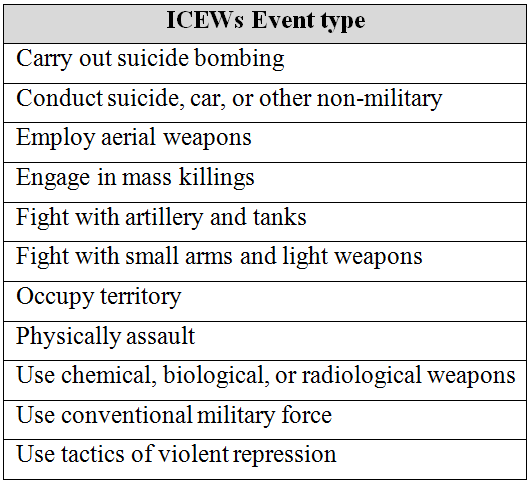
The event types were selected in order to capture the explicit use of force between military and/or civilian actors. The next step involved recoding a large number of actor names, the aim of which was to achieve consistency throughout the data. For example, we coded ‘Armed Band’, ‘Armed Gang’, ‘Armed Opposition’ and ‘Armed Rebel’ simply as ‘Rebels’. Consistency in actor names is crucial, otherwise ‘Armed Gang’ and ‘Armed Band’ would represent separate nodes, when for the sake of our study, both are NAGs. Finally, we took the liberty of removing entries that were obviously errors in machine-coding. For instance, the Britain-based Syrian Observatory for Human Rights (SOHR) was often reported to have killed civilians. All data was organised into months and graphs were produced using NodeXL.[3] We use the Harel-Koren Fast Multiscale algorithm to make all edges approximately the same length and minimises line crossings, and therefore, nodes are not placed relative to their connectedness. Instead, the size and colour of the links represent the intensity of conflictual events between nodes and the arrow of each link shows the direction of violence. Thin blue lines (or edges) represent low intensity conflictual relations between actors (nodes) while thick red lines represent high intensity conflictual relations. Grouped nodes are represented by different colours. This is included to facilitate the understanding of the graphs but grouping is not considered in the analysis. The graphs include an average of 231 stories per month for the Libyan conflict and 439 stories per month for the Syrian conflict.[4]
Graph 1: Libya, February 2011.

Graph 2: Syria, March 2011.

5.2 Results and Analysis
5.2.1 The Onset of Civil War
Graph 1 and Graph 2 support Tudoroui’s (2015: 147) observation that the 2011-12 general development of the Syrian crisis almost seemed to duplicate the Libyan Civil War. Violence broke out in Syria in March 2011 in the city of Deraa, where government forces shot and killed protesters demanding the release of political prisoners. One month earlier protestors clashed with police in the Libyan city of Benghazi. The Gaddafi and Assad regimes both resorted to military force against demonstrators instead of enacting reforms, thereby provoking armed insurrections (Hughes 2013: 523). This is clearly portrayed in our network analysis. The width and colour of the edges illustrate how the governments used political violence against civilians and protesters in an attempt to end the uprisings.
Graph 3: Libya, March 2011.

Graph 4: Libya, May 2011.

Graph 5: Libya, August 2011.

Graph 6: Libya, September 2011.
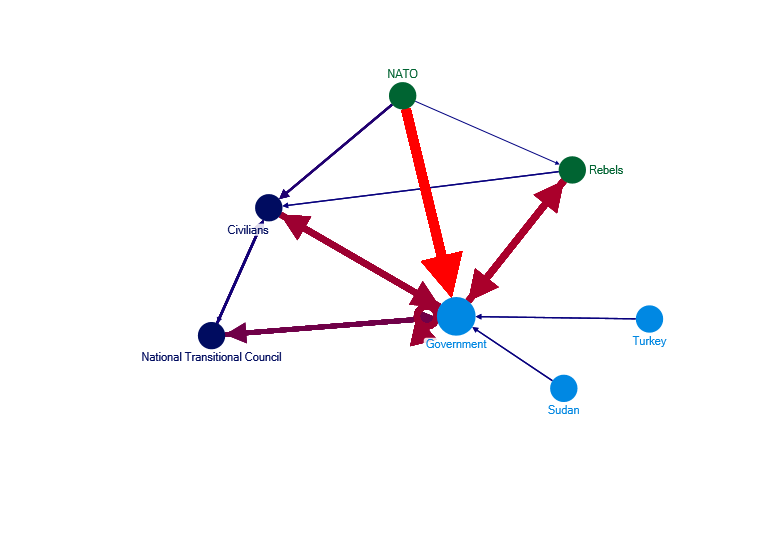
5.2.2 NATO’s Biased Intervention
On 17 March 2011 the United Nations authorised a no-fly zone over Libya and airstrikes to protect civilians under UN Resolution 1973. Days later, NATO forces launched air and maritime strikes against government troops surrounding rebels in the cities of Benghazi and Misrata. Until this point government victory seemed imminent (Tudoroiu 2013: 308). The intensity of NATO campaign is clear throughout our analysis, and explains why a number of states objected to what they saw as NATO overstepping the UN legal mandate by seeking regime change (Ulfstein & Christiansen 2013). Nevertheless, protesters and dissidents formed rebel groups, gained control of a number of cities and towns, and set up the National Transitional Council (NTC). Al Qaeda were present, but their presence was dwarfed by that of NATO, NATO-backed rebels and the Libyan government.
By May 2011, the rebels had organised a cohesive force to fight the government, while the government’s capability to fight was seriously reduced by NATO strikes. With the help of non-fungible external military support the rebels were effectively challenging the government. Importantly, interrebel competition did not undermine the rebellion. Although the data provided by the ICEWS does not account for different NAGs, the conflict dynamics show that the rebels focused their military effort towards fighting Gaddafi forces.
By September, 2011 the NTC had emerged as an important rebel representative and the government was increasingly under attack. The number of conflict actors was low and interrebel competition did not deter the military effort against the government. This is significant because we now know that civil war broke out in July 2014 following three years of growing tension between the internationally recognised government and an Islamist-led coalition (Strategic Comments 2014). The non-fungible support provided to Libyan rebel forces fostered the conditions for a cohesive military effort against the Gaddafi regime despite conflicting preferences between rebel groups which would later mature into a civil war.
Graph 7: Syria, May 2011.
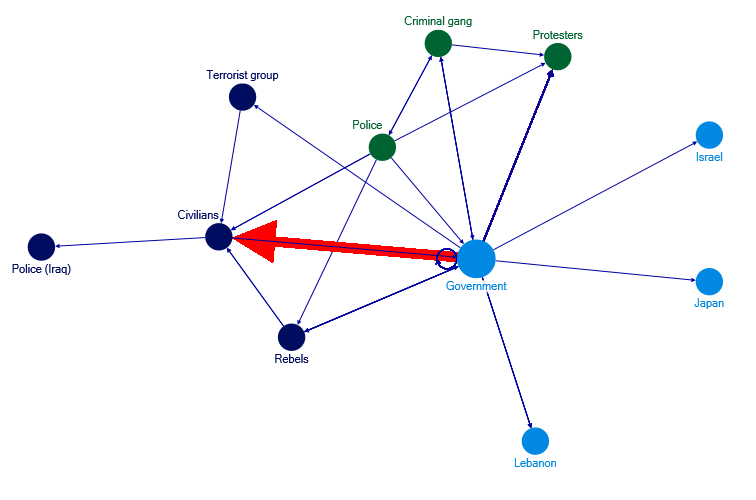
Graph 8: Syria, October 2011.
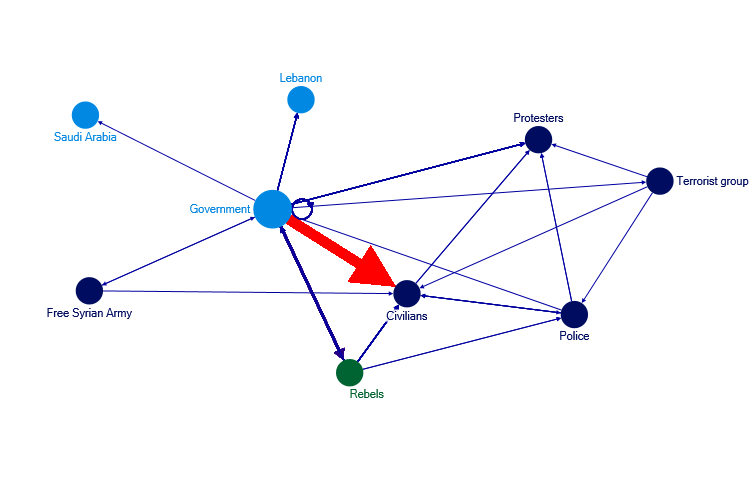
Graph 9: Syria, May 2012.
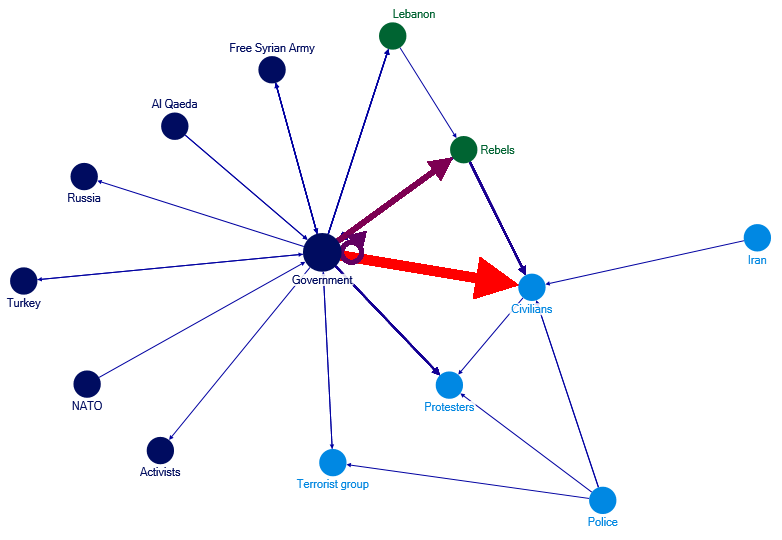
Graph 10: Syria, October 2012.
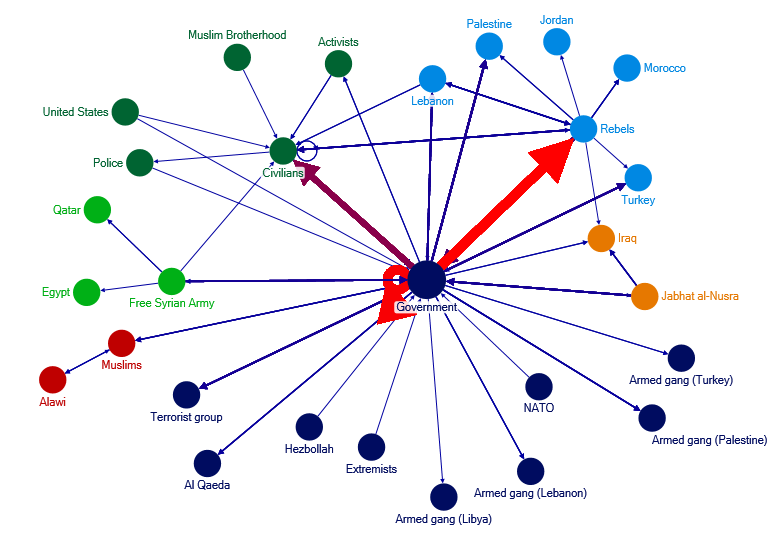
Graph 11: Syria, July 2013.
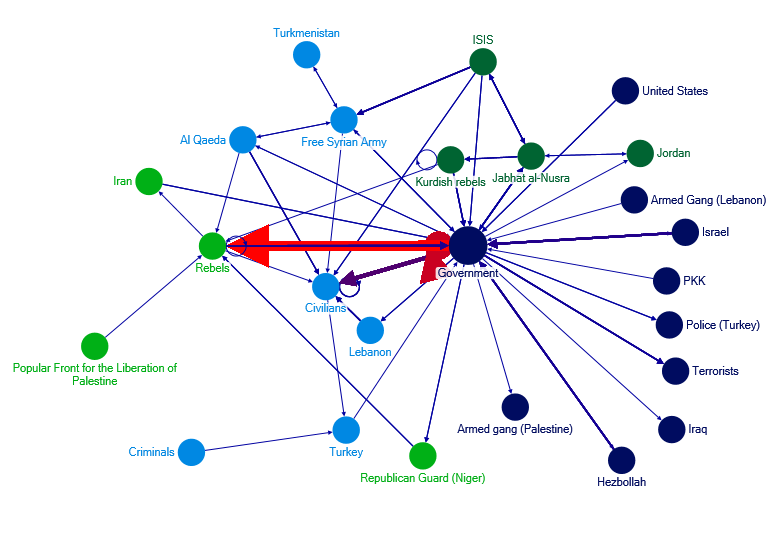
Graph 12: Syria, December 2013.
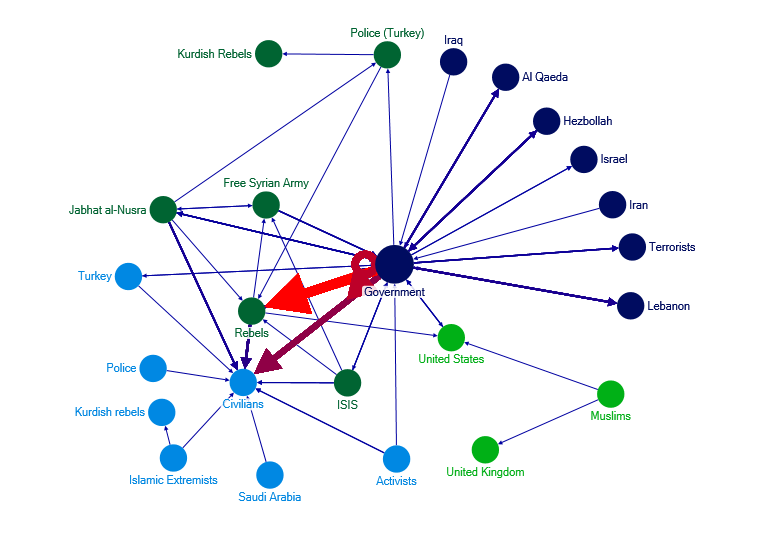
5.2.3 Syria’s Fragmented War
In May 2011, Bashar Al-Assad ordered military forces into Banyas, Deraa and Homs in an attempt to end the rebellion. The majority of violence was directed towards both protesters and civilians, while criminal gangs and terrorist groups emerged from the chaos. The same month saw the EU, the US and the Arab League increase economic sanctions against the Assad regime for violating human rights (New York Times 2011).
The social network graphs demonstrate the emergence of some order amongst rebel groups as the conflict progresses, particularly in the form of the Free Syrian Army (FSA). The FSA was first announced in July 2011 by defected military officers. The machine-coded data included the FSA but did not account for other rebel groups, such as those over which is supposedly had control such as the Farouk Brigade, or groups that emerged in 2012 like the Tawhid Brigade, the Idlib Martyrs’ Brigade or the National Unity Brigades (Carnegie Endowment 2015). Nevertheless, the graphs show an attempt to form rebel coalitions to fight the government.
The number of actors multiplies rapidly henceforth. In fact, our analysis shows that it continues to multiply as the Syrian conflict matures – reaching a total of 32 in November 2012. Jabhat Al-Nusra and Hezbollah both made an appearance by October 2012. Armed gangs from other countries like Turkey, Palestine, Lebanon and Libya were also involved. The FSA was no longer the only challenge to the government as an ever greater number of groups emerged. The Syrian Civil War became more fragmented and all sides struggled to impose themselves militarily. In comparison, following the NATO air campaign against the Gaddafi regime, there was a steep decline in the number of conflict actors in the Libyan Civil War.
In November 2012, the Syrian National Coalition (SNC) was established in an effort to gain more widespread international recognition and receive greater material and financial support (Carnegie Endowment 2013). By July 2013, the Kurdish militias, Jabhat Al-Nusra, ISIS and the FSA were all present, but NAGs were increasingly fighting each other. The most mediatised fighting involved IS and Jabhat Al-Nusra, but ISIS also fought FSA militias (see Zelin 2014; Landis 2014). As more agendas emerge, the fight between government and rebels, although still centre stage, was accompanied by a multitude of group rivalries and opposing preferences. Hughes (2013: 527) warned that if Syria became a proxy war, factionalism would be exacerbated and lead to internecine violence between rival insurgent movements. Based on this study, Syria had already become a proxy war by July 2013 and these forecasts were already a reality.
5.2.4 Discussion
The dominant form of external support in Libya was non-fungible, which increased the incentives for rebel groups to fight cohesively against the government. Although the Syrian conflict shares many characteristics with the Libyan Civil War, large influxes of fungible external support changed interrebel dynamics in Syria, and ultimately, the course of the war. Our network analysis indicates that the form of external support and the number of external supporters affects the degree of external involvement and the strategic interactions between NAGs. As can be seen in Libya 2011, when a strong external actor backs a rebel group with non-fungible support, other states with less to gain shy away and an environment of cooperation is fostered among rebel groups. In Syria however, no external actor imposed itself decisively behind one side, resulting in much external involvement, many sponsors and abundant supplies of fungible support to a growing number of NAGs. We have not sought to explain why external involvement in these conflicts was different, an answer which is rooted in international rivalries and geopolitics. Instead, we outlined the development of conflictual behaviours. Although our theoretical argument is not the only element at play, it stands out as a decisive factor.
VI. CONCLUSION
We have explored the external factors which influence relations between conflict actors at a meso-level, namely external state support to NAGs. Our large-N analysis offers interesting results that weakly support our theoretical argument. We expect that the theory behind support fungibility requires more work, but also that the composition of our statistical models are problematic. Indeed, many groups receive different forms of support from different external actors, a complexity that our analysis overlooks. Although a NAG may receive military support from a sponsor, the same or different external state can provide them with other forms of support. For instance, our merged data shows that in 1997 the Cobra Militia in the Republic of the Congo received external support from France, Chad and Angola. France supplied funding/economic support, whereas both Chad and Angola provided weapons and troops. Furthermore, our theoretical argument does not account for non-state actors. In the same instance, the Cobras received funding/economic support from Elf Aquitaine, a French energy company. There is a huge risk of homogeneity in this type of study, and unfortunately, its construction means it can only provide us with an indication of what effect each form of support has on NAG behaviour. Further research should employ a dyadic approach which also accounts for the origin of the support, the number of external sponsors (both states and non-state actors), the timing of external involvement, its duration, and crucially, an indicator of NAG dependency on external support.
Having outlined the shortcomings of our large-N study, it is important to highlight promising results that reinforce previous findings – different forms of support have diverging and statistically significant effects on NAG behaviour. Moreover, it is not merely the intensity of their behaviour that is shaped by external support types, but also its direction. For instance, although support in the form of troops drastically decreases the probability that a NAG will be in an alliance, access to territory increases this probability compared to groups that do not receive external support. Having outlined the importance of understanding external support, there is no doubt that research must further our understanding of external support’s diverging effects on NAG behaviour.
We complimented the mixed findings of the large-N study with a preliminary network analysis of the Syrian and Libyan civil wars. This confirmed the findings from section 4 that fungible support (weapons and funding/economic) induces NAGs to compete and ultimately fight each other, and to some extent, that non-fungible support can foster the conditions for groups to work together. We recommend that further study replicates this network analysis with the addition of factions as opposed to rebel groups. K. Cunningham et al. (2012) emphasise that separatist disputes are rarely dyadic, but instead contain self-determination movements representing a number of factions which compete with one another for political and material gains. Our theory on the fungibility of resources may be more applicable to a faction level account of competition and cooperation.
The Syrian conflict illustrates why it is important for policy-makers and the international community to understand how external support shapes interrebel dynamics, the emergence of rival rebel groups and, ultimately, conflict characteristics like duration, outcome and intensity. The emergence of ISIS and its incredible brutality shocked the world. Brinton (1965) argued that competition in a revolutionary context shifts power from moderates to radicals as the most brutal and determined among rival groups survive. Our theoretical argument does not explain how a group like ISIS thrived in Syria and Iraq, but interrebel competition induced by fungible external support may explain how the seeds of ISIS were sown. This highlights the importance of creating policy which aims to reduce competition between rebel groups. Reducing legal incentives for states to provide highly fungible resources rooted in international law seems an obvious place to start.
VII. APPENDIX
Table 1: Comparison of UCDP Data and merged Interrebel Fighting Dataset.

Table 2: Comparison of UCDP Data and merged Rebel Alliances Dataset.

Table 3: Descriptive Statistics for Interrebel Fighting Dataset.
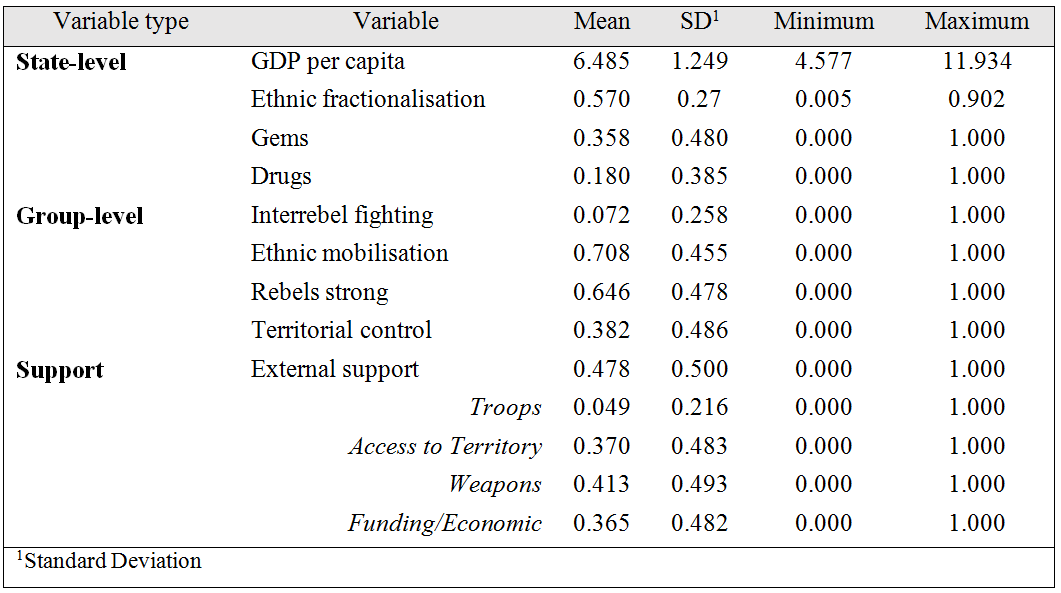
Table 4: Descriptive Statistics for Rebel Alliances Dataset.
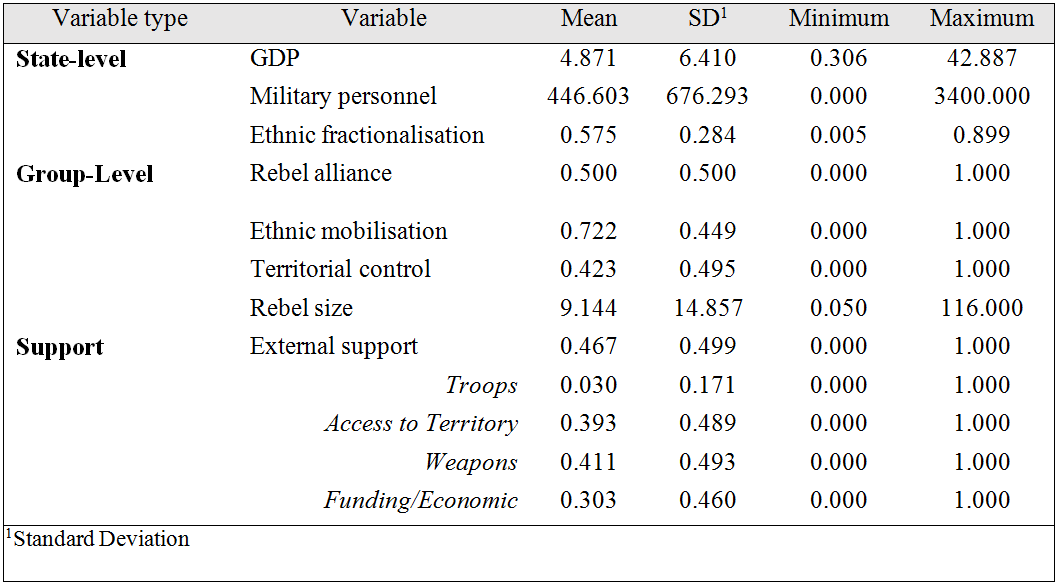
Table 5: Forms of external support included in UCDP External Support Data v. 1-2011.
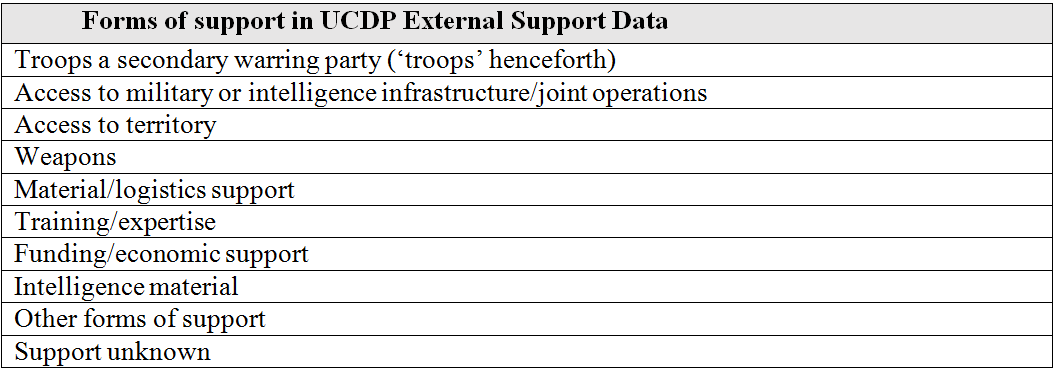
Table 6: Sample of Network Analysis Data – Libyan Civil War, 11/05/2011.
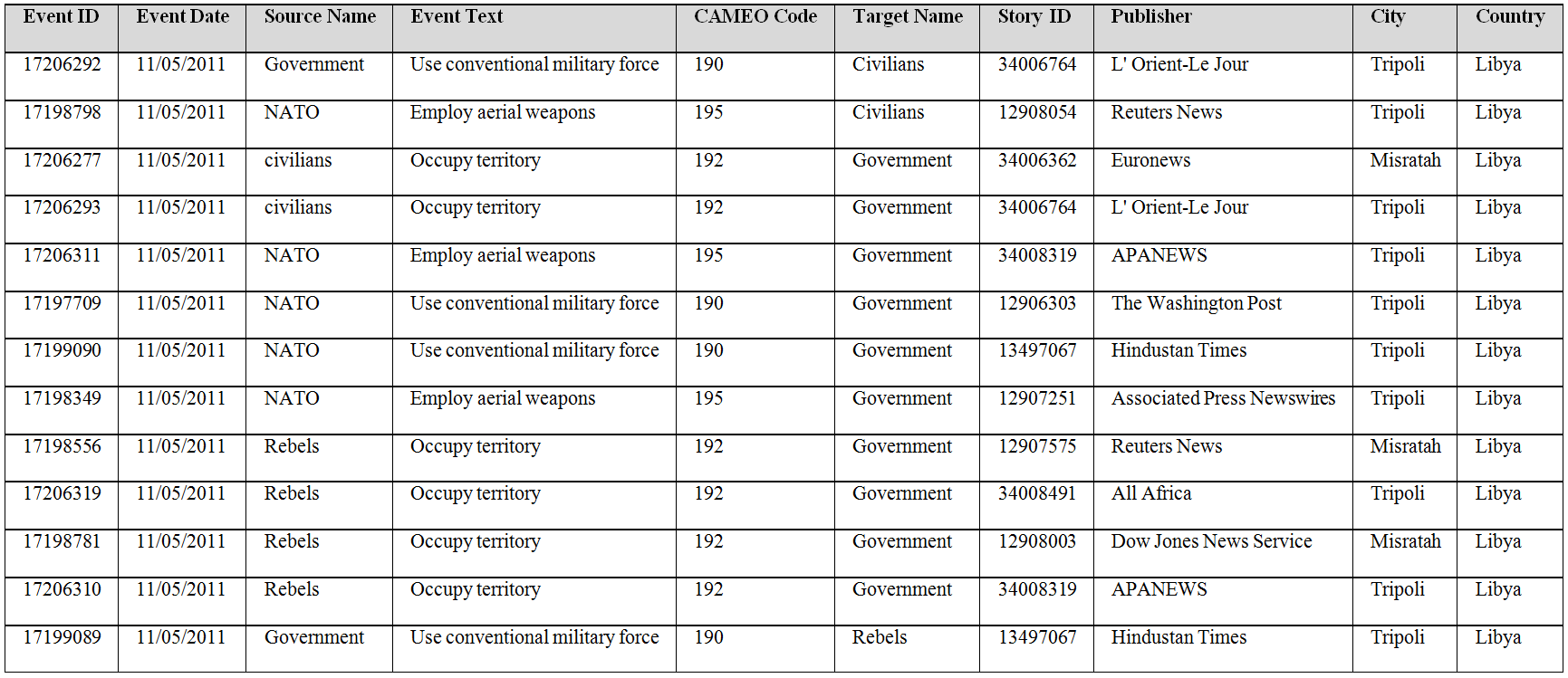
Stata Do-File
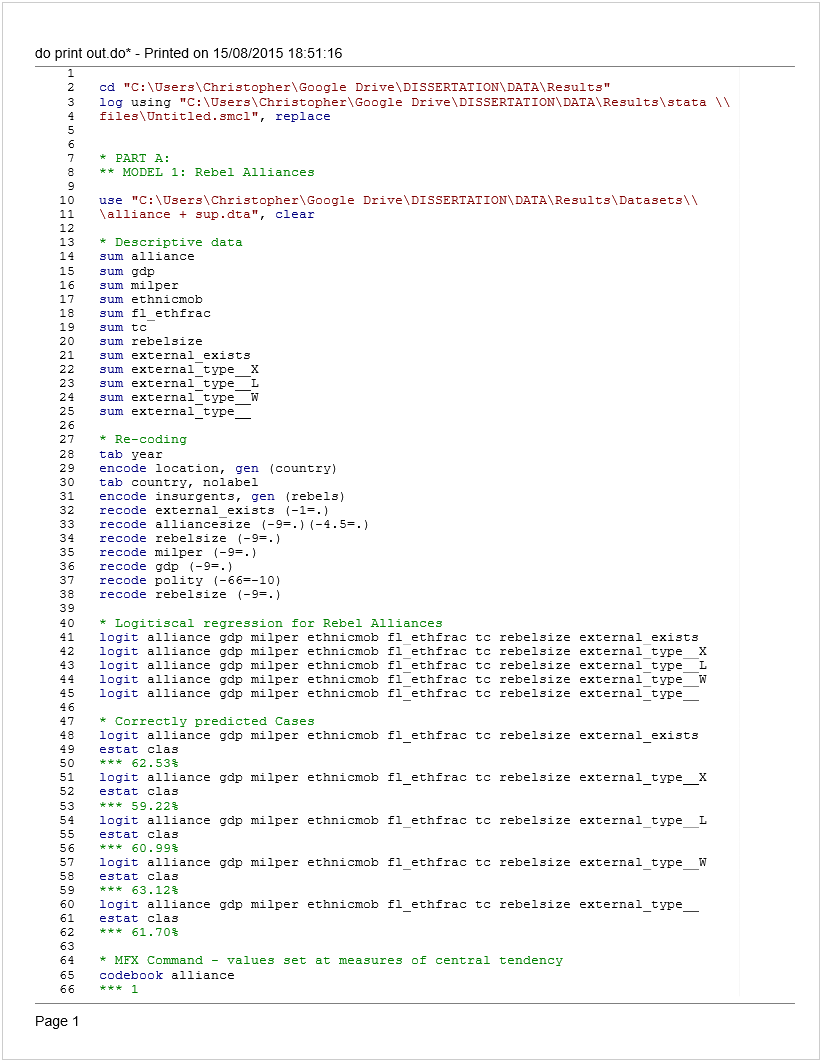
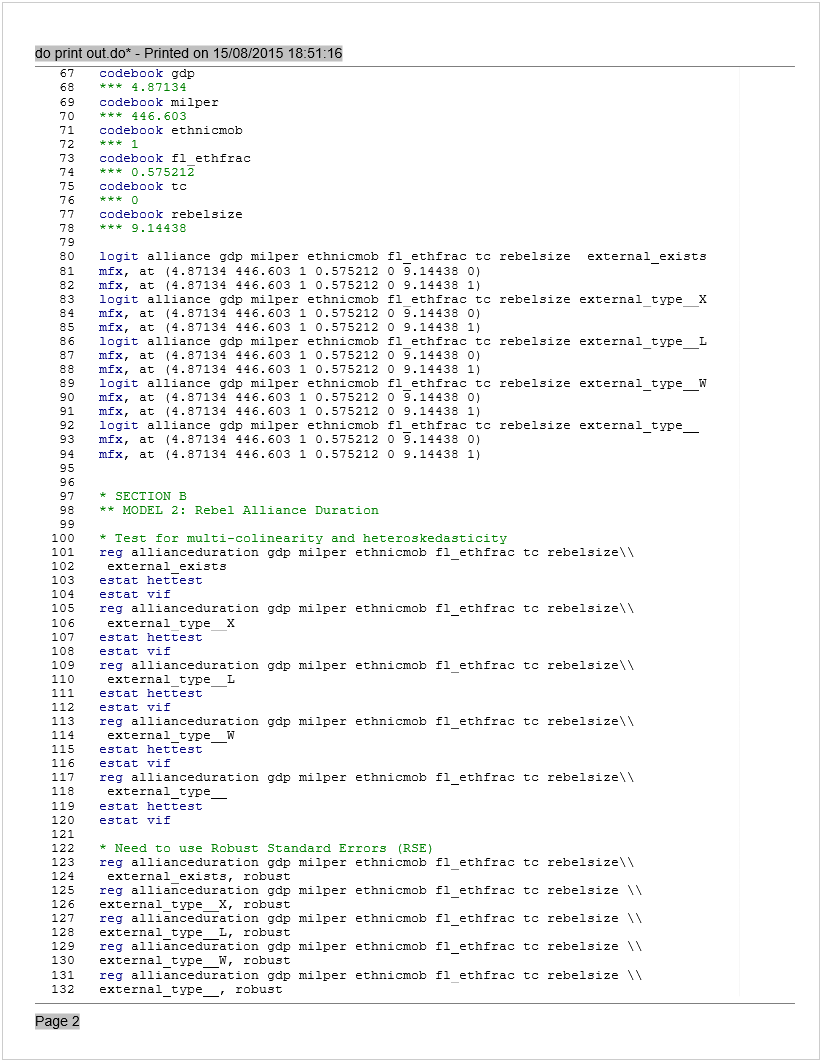
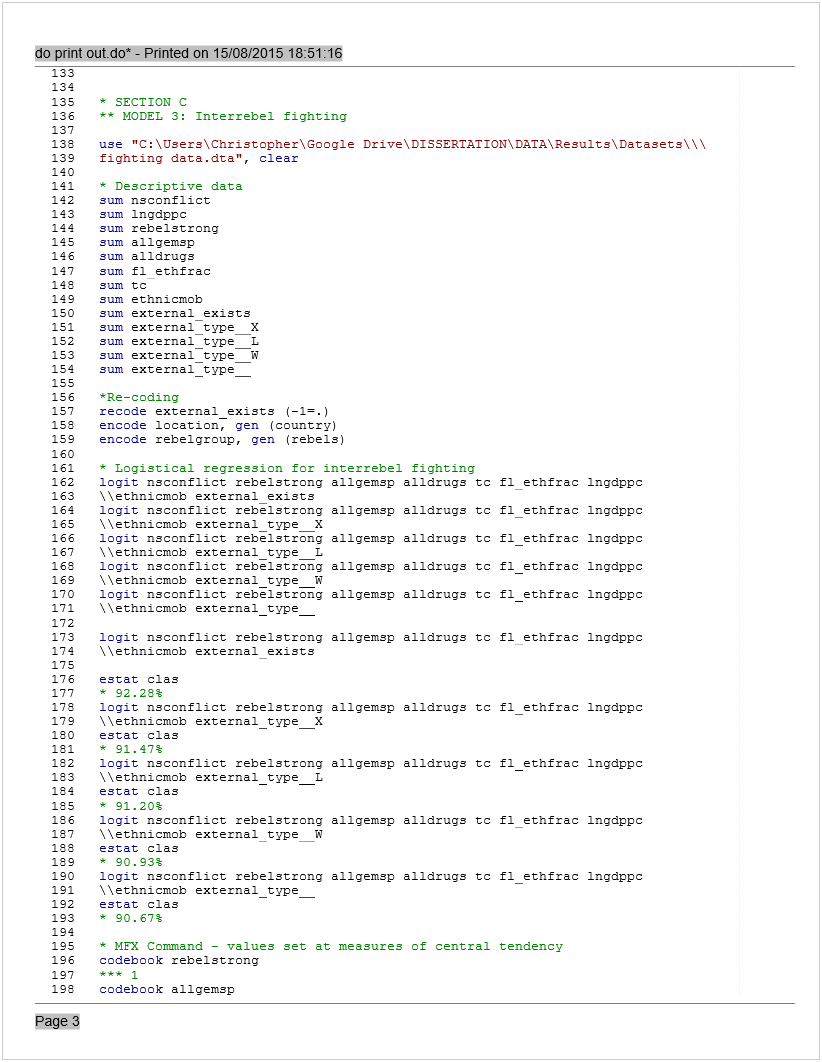
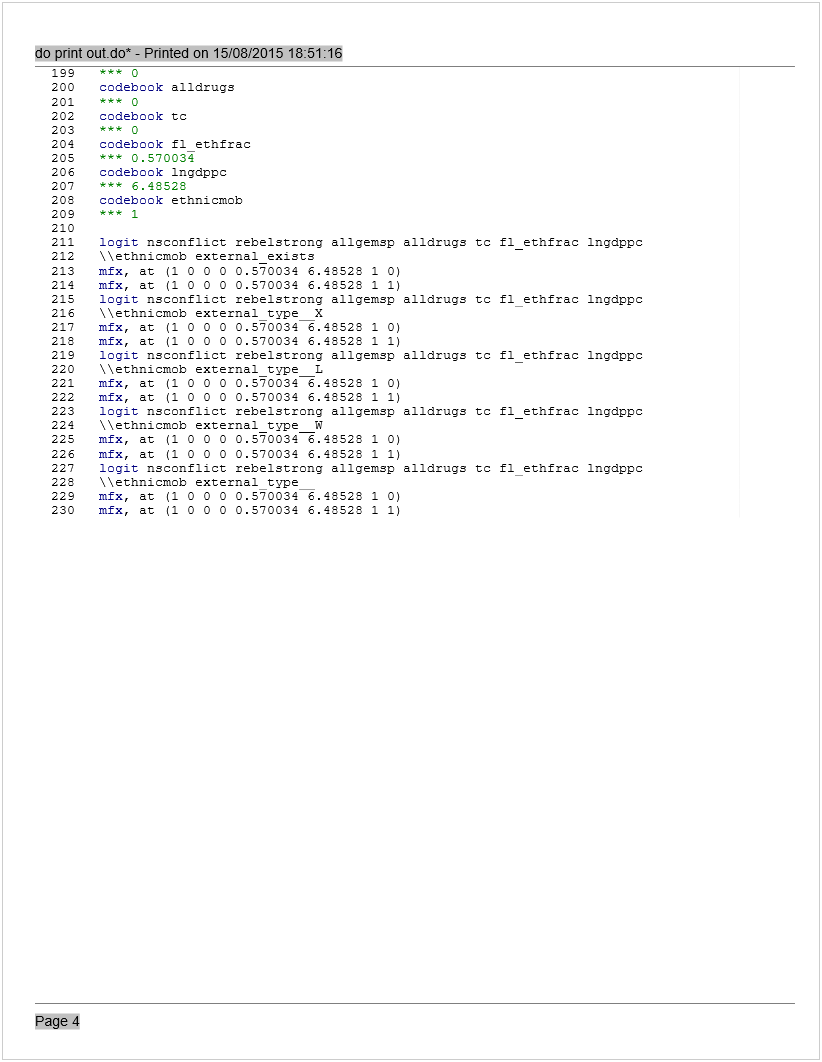
Libyan Civil War 2011: Graph Metrics
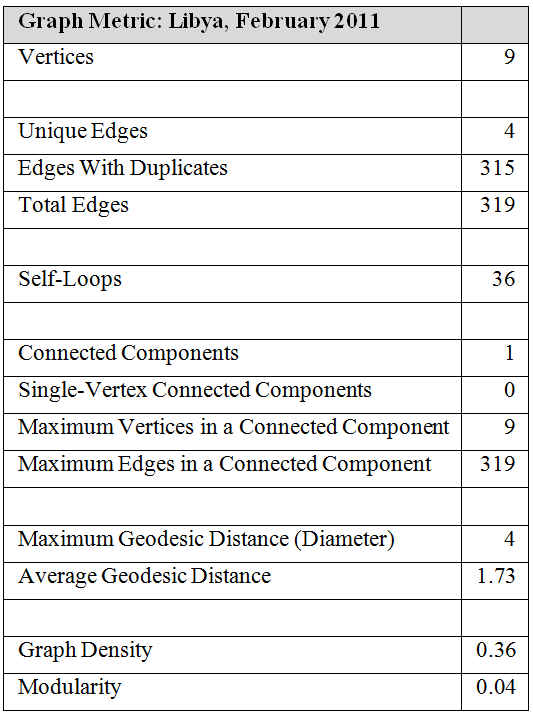
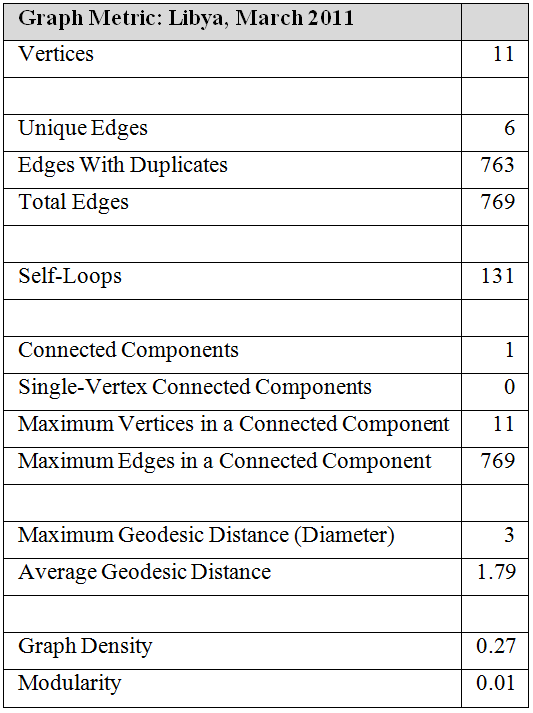
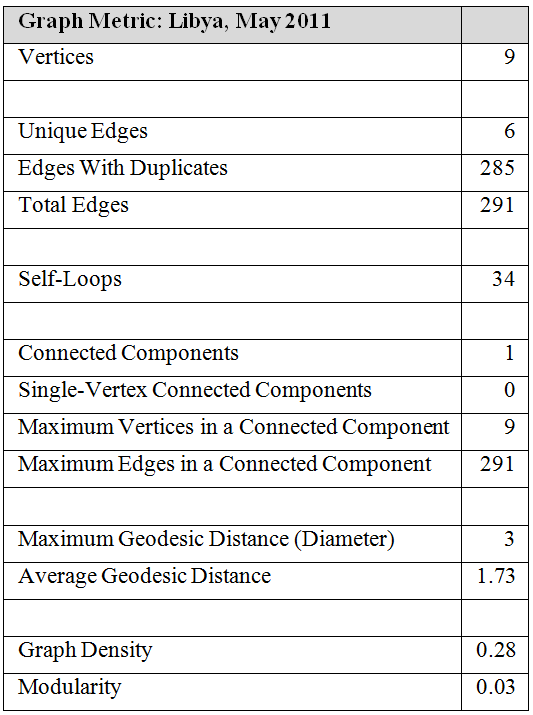
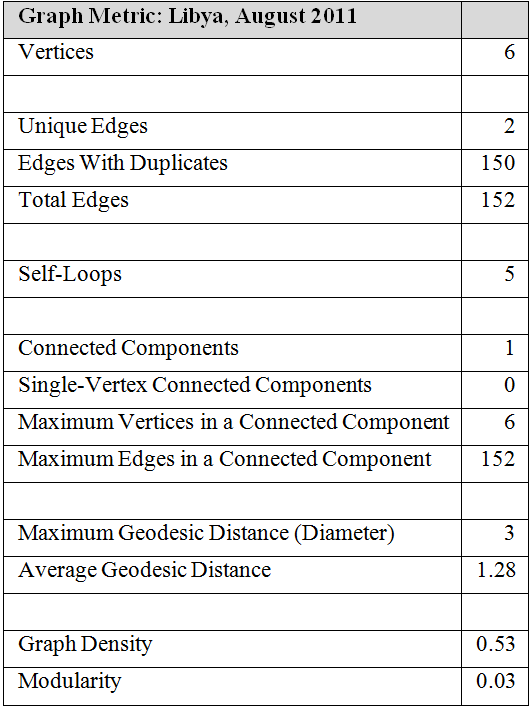
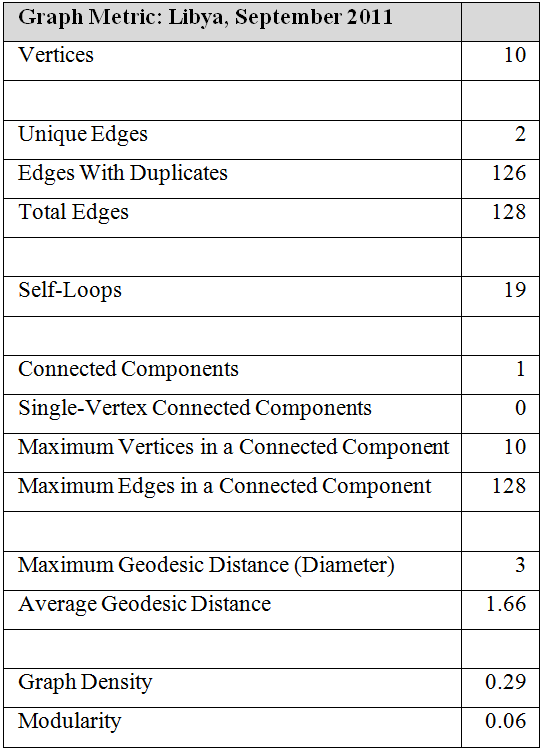
Syrian Civil War 2011-2013: Graph Metrics
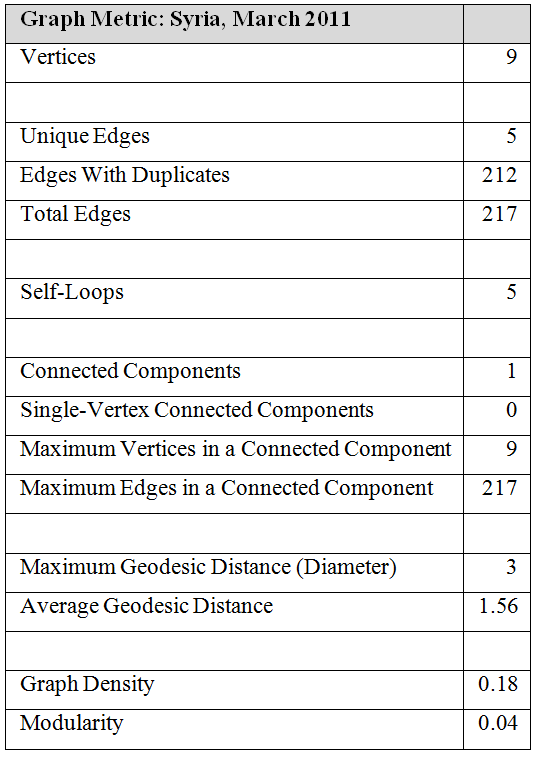
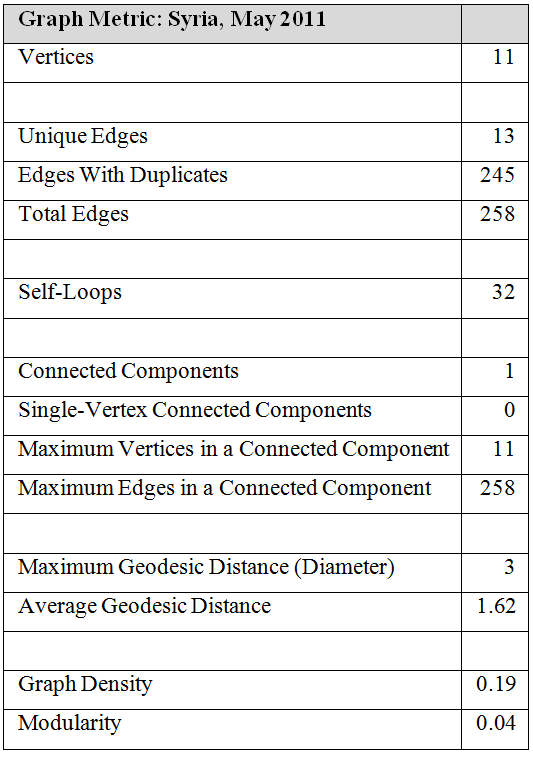
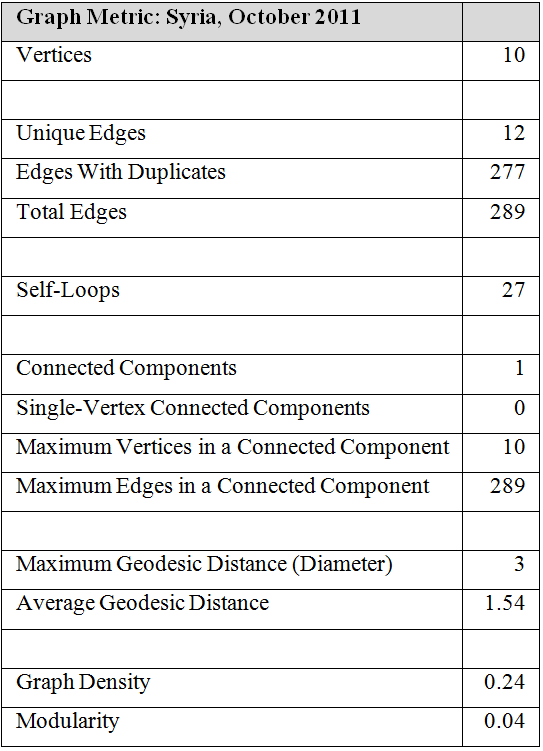
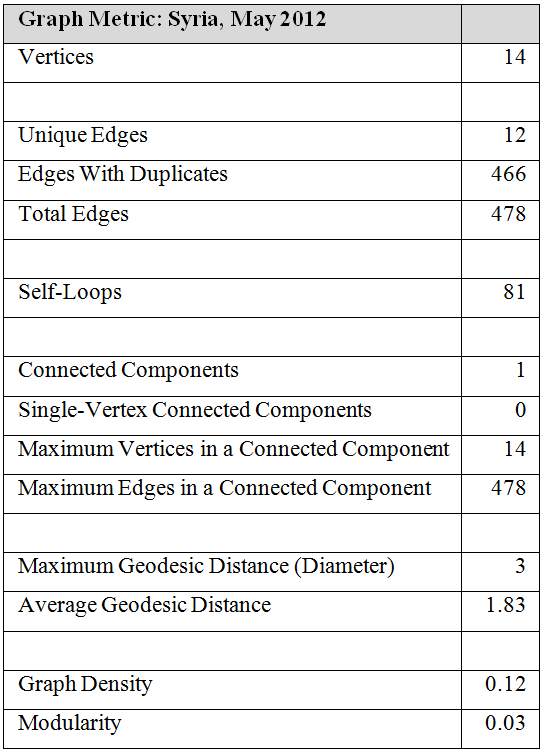
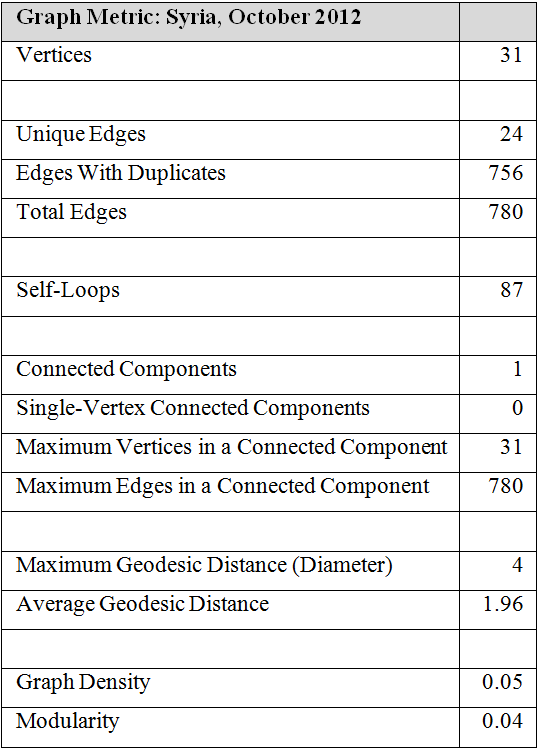
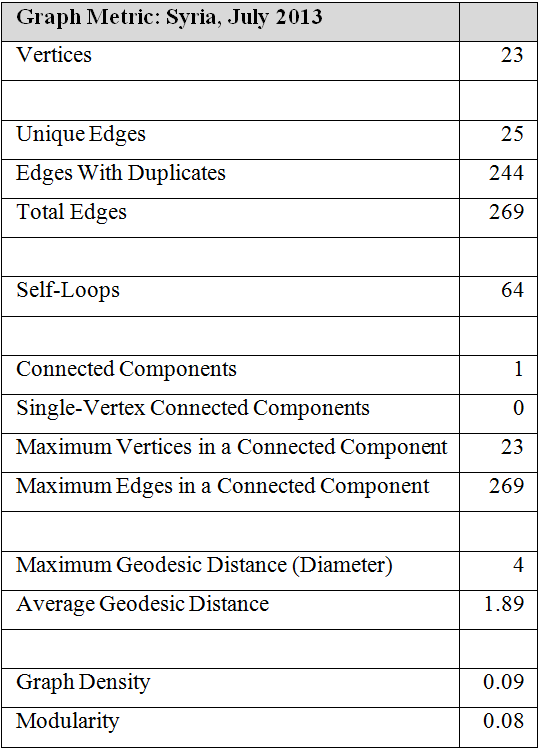
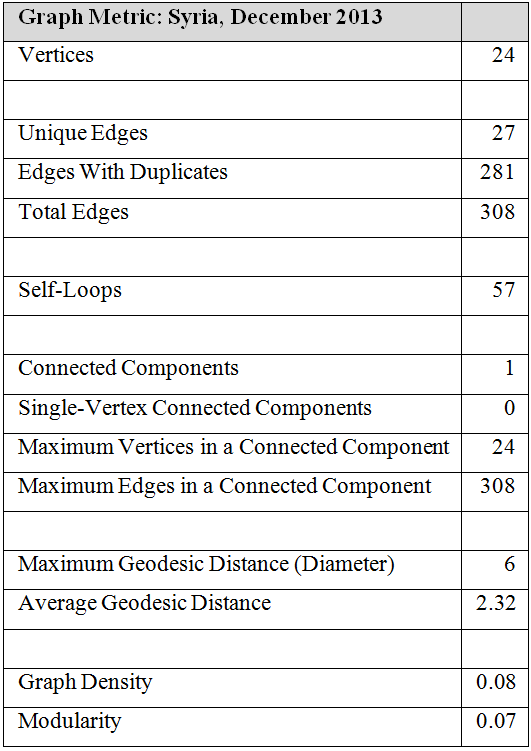
VIII. REFERENCES
Data
Integrated Crisis Early Warning System (ICEWs) Dataverse (Lockheed Martin et al.)
Boschee, E., Lautenschlager, J., O’Brien, S., Shellman, S., Starz., J., & Ward, M. (2015). ‘ICEWs Coded Event Data’. Available at http://www.dataverse.harvard.edu [accessed on 05/08/15].
UCDP External Support – Primary Warring Party Dataset v. 1.0-2011
Högbladh, S., Pettersson, T., & Themnér, L. (2011). ‘External Support in Armed Conflict 175-2009. Presenting New data.’ Paper presented at the 52nd Annual International Studies Association Convention, Montreal, Canada, 16-19 March, 2011. Available at: http://www.pcr.uu.se [accessed on 05/08/15].
Media
BBC NEWS. (2015). Syria: The Story of the Conflict. BBC NEWS [online] 12th March. Available from: http://www.bbc.com [accessed on 05/08/15].
Carnegie Endowment (2013). Syria’s Armed Opposition: A Brief Overview [online]. Available from: http//:www.carnegieendowment.org [accessed on 12/08/15].
Carnegie Endowment (2015). National Coalition for Syrian Revolutionary and Opposition Forces [online]. Available from: http//:www.carnegieendowment.org [accessed on 05/08/15].
Economist (2015). Iran and Saudi Arabia: Proxies and Paranoia. The Economist [Online]. Available from http//:www.economist.com [accessed on 05/08/15].
Foreign Policy. (2015a). Will Curbing Iran’s Nuclear Threat Boost its Proxies? Foreign Policy [online] 20th July. Available from: http://foreignpolicy.com [accessed on 05/08/15].
Foreign Policy. (2015b). 10 Wars to Watch in 2015. Foreign Policy [online] 2nd January. Available from: http://www.foreignpoliy.com [accessed on 05/08/15].
New York Times. (2011). Isolating Syria, Arab League Imposes Broad Sanctions. The New York Times [online] 27th November. Available from: http://www.nytimes.com [accessed on 05/08/15].
New York Times. (2015). In Ukraine, It’s Putin’s Game. The New York Times [online] 11th February. Available from: http://www.nytimes.com [accessed on 05/08/15].
Reuters. (2014). Iranian Support Seen Crucial for Yemen’s Houthis. Reuters [online] 15th December. Available from: http://www.reuters.com [accessed on 05/08/15].
Academic Literature
Akcinaroglu, S. & Radziszewski, E. (2005). ‘Expectations, Rivalries, and Civil War Duration’. International Interactions, 31 (4), 349-374.
Akcinaroglu, S. (2012). ‘Rebel Interdependencies and Civil War Outcomes’, The Journal of Conflict Resolution, 56(5), 879–903.
Altunişik, M. & Tür, O. (2006). ‘From Distant Neighbors to Partners? Changing Syrian–Turkish Relations’, Security Dialogue, 37(2), 229–248.
Bakke, K., Cunningham, K., & Seymour, L. (2012). ‘A Plague of Initials: Fragmentation, Cohesion, and Infighting in Civil Wars’, Perspectives on Politics, 10(2), 265–283.
Balch-Lindsay, D., Enterline, A., & Joyce, K. (2008). ‘Third-Party Intervention and the Civil War Process’, Journal of Peace Research, 45(3), 345–363.
Bapat, N. (2012). ‘Understanding State Sponsorship of Militant Groups’, British Journal of Political Science, 42(1), 1–29.
Bapat, N., & Bond, K. (2015). ‘Alliances between Militant Groups Alliances between Militant Groups’, The British Journal of Political Science, 42(4), 793-824.
Blattman, C., & Miguel, E. (2010). ‘Civil War’, Journal of Economic Literature, 48(1), 3-57.
Bond, K. (2012). ‘Rebel Alliances and Negotiated Civil Conflict Outcomes’, Unpublished Article, University of Maryland, 1-31.
Brinton, C. (1965). The Autonomy of Revolution (London: Vintage).
Byman, D., Chalk, P., Hoffman, B., Rosenau, W., & Brannan, D. (2001). Trends in Outside Support for Insurgent Movements (Santa Monica CA, USA: RAND).
Carter, D. (2012). ‘A Blessing or a Curse? State Support for Terrorist Groups’, International Organisation, 66(1), 129-151.
Celso, A. (2015). ‘The Islamic State and Boko Haram: Fifth Wave Jihadist Terror Groups’, Orbis, 59(2), 249–268.
Charap, S. (2015). ‘Is Russia an Outside Power in the Gulf ?’, Survival: Global Politics and Strategy, 57(1), 153-170.
Cheterian, V. (2015). ‘ISIS and the Killing Fields of the Middle East’, Survival: Global Politics and Strategy, 57(2), 105-118.
Collier, P., Hoeffler, A., & Söderbom, M. (2004). ‘On the Duration of Civil War’, Journal of Peace Research, 41(3), 253–273.
Cunningham, D. (2006). ‘Veto Players and Civil War Duration’, American Journal of Political Science, 50(4), 875–892.
Cunningham, D. (2010). ‘Blocking resolution: How External States can Prolong Civil Wars’, Journal of Peace Research, 47(2), 115–127.
Cunningham, D., Gleditsch, K., & Salehyan, I. (2009). ‘It Takes Two: A Dyadic Analysis of Civil War Duration and Outcome’, Journal of Conflict Resolution, 53(4), 570-597.
Cunningham, K. (2011). ‘Divide and Conquer or Divide and Concede: How Do States Respond to Internally Divided Separatists?’, American Political Science Review, 105(2), 275–297.
Cunningham, K., Bakke, K., & Seymour, L. (2012). ‘Shirts Today, Skins Tomorrow: Dual Contests and the Effects of Fragmentation in Self-Determination Disputes’, Journal of Conflict Resolution, 56(1), 67–93.
Fearon, J. (1995). ‘Rationalist Explanations for War’, International Organisation, 49(3), 379-414.
Fearon, J. (2004). ‘Why Do Some Civil Wars Last So Much Longer Than Others?’. Journal of Peace Research, 41 (3), 275-301.
Fearon, J., & Laitin, D. (2003). ‘Ethnicity, Insurgency, and Civil War’, American Political Science Review, 97(1), 75-90.
Fjelde, H., & Nilsson, D. (2012). ‘Rebels against Rebels: Explaining Violence between Rebel Groups’. Journal of Conflict Resolution, 56(4), 604–628.
Forsythe, D. (1992). ‘Democracy, War, and Covert Action’, Journal of Peace Research, 29(4), 385-395.
Gleditsch, K., Salehyan, I., & Schultz, K. (2008). ‘Fighting at Home, Fighting Abroad: How Civil Wars Lead to International Disputes’, The Journal of Conflict Resolution, 52(4), 479-506.
Humphreys, M. (2005). ‘Natural Resources, Conflict, and Conflict Resolution: Uncovering the Mechanisms’, Journal of Conflict Resolution, 49(4), 508–537.
Humphreys, M., & Weinstein, J. (2008). ‘Who Fights? The Determinats of Participation in Civil War’, American Journal of Political Science, 52(2), 436–455.
Kalyvas, S. N., & Balcells, L. (2010). ‘International System and Technologies of Rebellion: How the End of the Cold War Shaped Internal Conflict’. American Political Science Review, 104(3), 415–429.
Keatinge, T. (2014). ‘The Importance of Financing in Enabling and Sustaining the Conflict in Syria (and Beyond)’, Perspectives on Terrorism, 8(4), 53-61.
Keohane, R. (1984). After Hegemony: Cooperation and Discord in the World Political Economy (Princeton NJ, USA: Princeton University Press).
Lacina, B. (2006). ‘Explaining the Severity of Civil Wars’, Journal of Conflict Resolution, 50(2), 276-289.
Landis, J. (2014). The Battle Between ISIS and Syria’s Rebel Militias [online] 9th January. Available from http://www.clarionproject.org [accessed on 05/08/15].
Le Billon, P. (2008). ‘Diamond Wars? Conflict Diamonds and Geographies of Resource Wars’, Annals of the Association of American Geographers, 98(2), 345–372.
Lilja, J., & Hultman, L. (2011) ‘Intra-Ethnic Dominance and Control: Violence against Co-Ethnics in the Early Sri Lankan Civil War’, Security Studies, 20(2), 171-197.
Lilja, J., & Hultman, L. (2011). ‘Intraethnic Dominance and Control: Violence Against Co-Ethnics in the Early Sri Lankan Civil War’, Security Studies, 20(2), 171–197.
Maoz, Z., & San-Akca, B. (2012). ‘Rivalry and State Support of Non-State Armed Groups (NAGs), 1946-2001’, International Studies Quarterly, 56(4), 720–734.
Metternich, N., Dorff, C., Gallop, M., Weschle, S., & Ward, M. (2013). ‘Antigovernment Networks in Civil Conflicts: How Network Structures Affect Conflictual Behavior’, American Journal of Political Science, 57(4), 892–911.
Nygård, H., & Weintraub, M. (2015). ‘Bargaining Between Rebel Groups and the Outside Option of Violence’, Terrorism and Political Violence, 27(3), 557-580.
Pearlman, W. (2009). ‘Spoiling Inside and Out’, International Security, 33(2), 79–109.
Pearlman, W., & Cunningham, K. (2012). ‘Nonstate Actors, Fragmentation, and Conflict Processes’, Journal of Conflict Resolution, 56(1), 3–15.
Petterson, T. & Wallensteen, P. (2015). ‘Armed Conflicts, 1946-2014’, The Journal of Peace Research, 52(4), 536-550.
Powell, R. (2002). ‘Bargaining Theory and International Conflict’, Annual Review Political Science, 5, 1-30.
Randelzhofer, A. (2002). ‘Article 2(4)’ in Simma, B., Mosler, H., Paulus, A, & Chaitidou, E. (2002). The Charter of the United Nations (Oxford: Oxford University Press).
Regan, P. M. (2002). ‘Third-party Interventions and the Duration of Intrastate Conflicts’, Journal of Conflict Resolution, 46(1), 55–73.
Ross, M. (2003). ‘Oil, Drugs, and Diamonds: How do Natural Resources Vary in their Impact on Civil War?’ in Beyond Greed and Grievance: The Political Economy of Armed Conflict, ed. Ballentine, K. & Sherman, J. (US, Boulder: Lynne Rienner Publishers)
Ross, M. (2004). ‘How Do Natural Resources Influence Civil War? Evidence from Thirteen Cases’, International Organizations, 58(1), 35-67.
Salehyan, I. (2008). ‘No Shelter Here: Rebel Sanctuaries and International Conflict’, The Journal of Politics, 70(1), 54–66.
Salehyan, I. (2010). ‘The Delegation of War to Rebel Organisations’, The Journal of Conflict Resolution, 54(3), 493-515.
Salehyan, I. (2011). ‘External Rebel Sponsorship and Civilian Abuse: A Principal-Agent Analysis of Wartime Atrocities’, International Organization, 68(3), 633-661.
Salehyan, I., Gleditsch, K., & Cunningham, D. (2011). ‘Explaining External Support for Insurgent Groups’, International Organization, 65(4), 709–744.
San Akca, B. (2009). ‘Supporting Non-State Armed Groups: A Resort to Illegality?’, Journal of Strategic Studies, 32(4), 589–613.
Sawyer, K., Cunningham, K., & Reed, W. (2015). ‘The Role of External Support in Civil War Termination’, Unpublished Article, University of Maryland, 1-44.
Sobek, D., & Pyne, C. (2010). ‘A Tale of Two Types: Rebel Goals and the Onset of Civil Wars’, International Studies Quaterly, 54(1), 213-240.
Strategic Comments (2014). ‘Libya’s Civil War: the essential briefing’, Strategic Comments, 20:10, ix-iv.
Tudoroiu, T. (2015). ‘The Reciprocal Constitutive Features of a Middle Eastern Partnership : The Russian-Syrian Bilateral Relations’, Journal of Eurasian Studies, 6(2), 143–152.
Ulfstein, G. & Christiansen, H. (2013). ‘The Legality of the NATO Bombing in Libya’, International and Comparative Law Quarterly, 62(1), 159-171.
Van Um, E. (2012). ‘Why Militant Groups Fight Each Other : The Role of Support, Political Objectives and Revenge’, Economic of Security Working Paper 64, Berlin: Economics of Security.
Wagner, R. (2000). ‘Bargaining and War’, American Journal of Political Science, 44(3), 469-484.
Zelin, A. (2014). ‘The War between ISIS and Al-Qaeda for Supremacy of the Global Jihadist Movement’, The Washington Institute for Near East Policy, 20, 1-11.
Zohar, E. (2015). ‘The Arming of Non-State Actors in the Gaza Strip and Sinai Peninsula’, Australian Journal of International, 1-24.
UN Documents
Case Concerning Military and Paramilitary Activities in and Against Nicaragua (Nicaragua v. United States of America); International Court of Justice (ICJ), 27 June 1986, available at http://icj-cij.org [accessed on 05/08/2015].
Philip, A. (2010). Study on Targeted Killings – Addendum to the Report of the Special Rapporteur on Extrajudicial, Summary or Arbitrary Executions. ¶¶ 18-22, 34-45.
United Nations, General Assembly (2011). Resolution 1973, S/RES/1973. Available from http://www.nato.int [accessed on 05/08/15].
United Nations. (1945). Charter of the United Nations and Statute of the International Court of Justice. (New York: United Nations, Office of Public Information).
ENDNOTES
[1] Descriptive statistics and comparative statistics for both datasets can be found in the appendix.
[2] see Metternich et al. (2013)
[3] Information on NodeXL can be found at http://www.nodexl.codeplex.com [accessed on 05/08/15]
[4] Network metrics for graphs illustrated below can be found in the appendix.
Written by: Christopher Rickard
Written at: University College London
Written for: Kristin Bakke
Date written: 01/09/2015
Further Reading on E-International Relations
- Women at War in the Middle East: Gendered Dynamics of ISIS and the Kurdish YPJ
- Nuclear Non-Proliferation and Imperialist Dynamics in International Law
- The Angolan Civil War: Conflict Economics or the Divine Right of Kings?
- UN Intervention: Help or Hindrance in the Democratic Republic of Congo?
- To What Extent Is ‘Great Power Competition’ A Threat to Global Security?
- Europe’s Biggest Eurosceptics: Britain and Support for the European Union